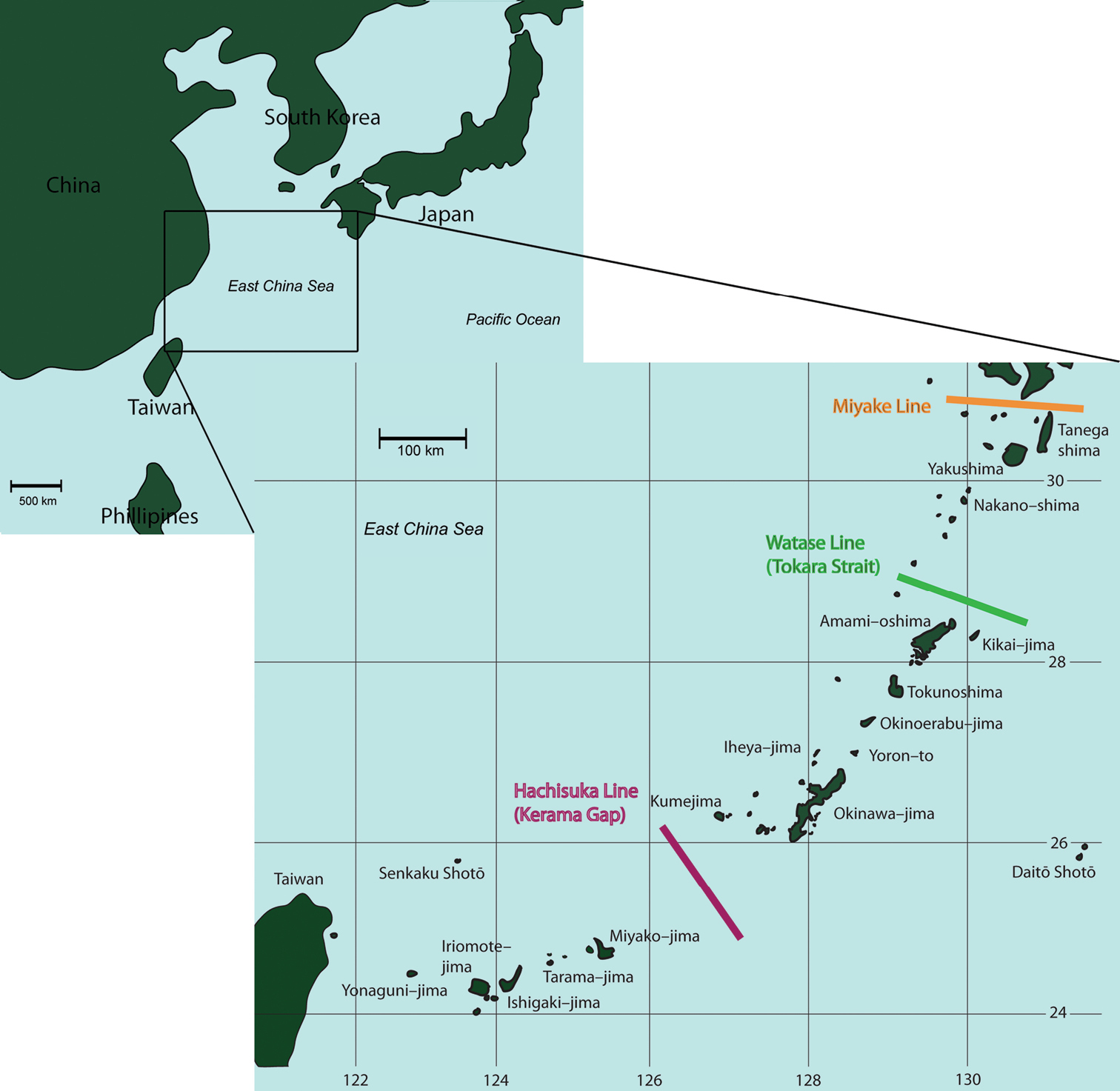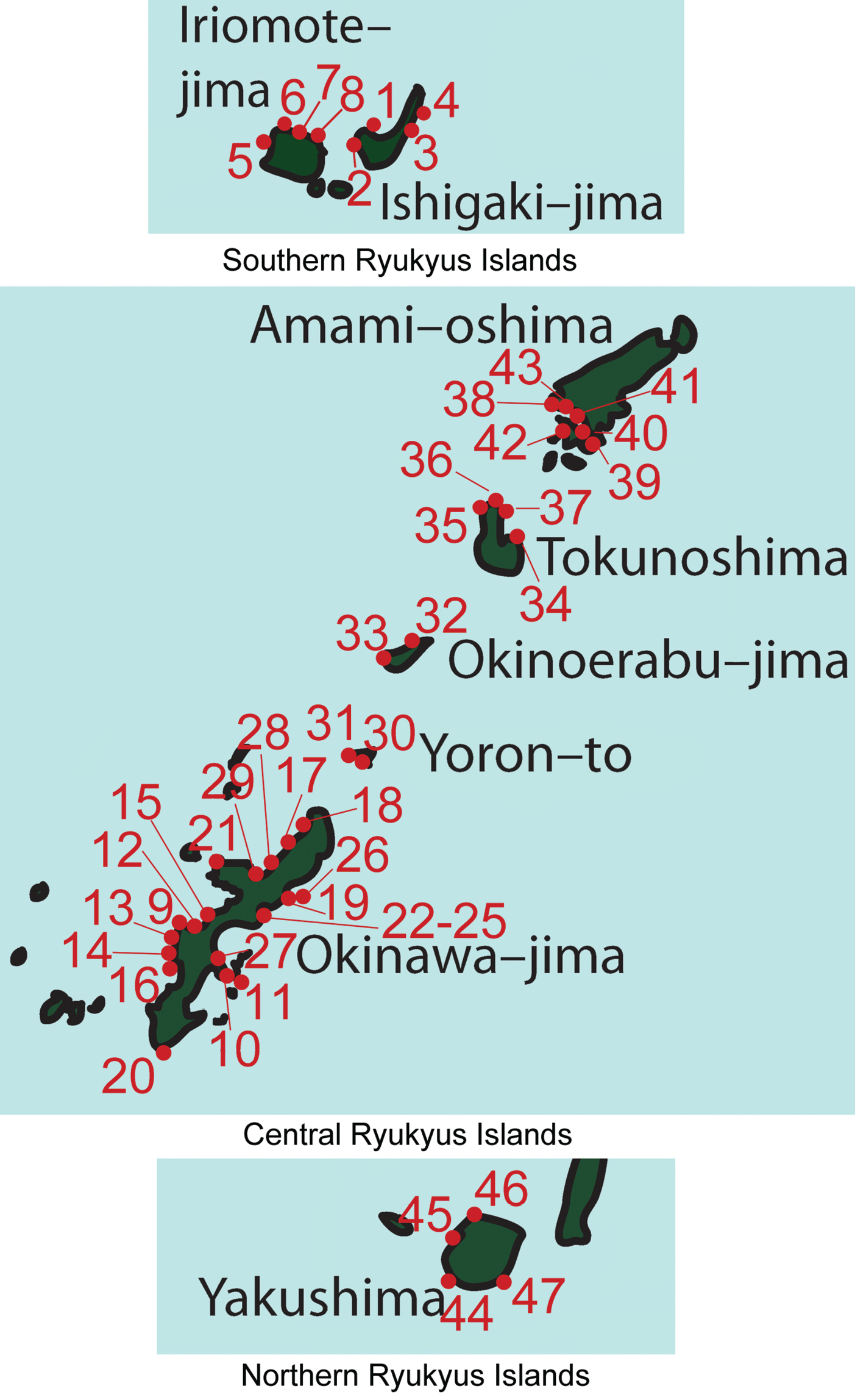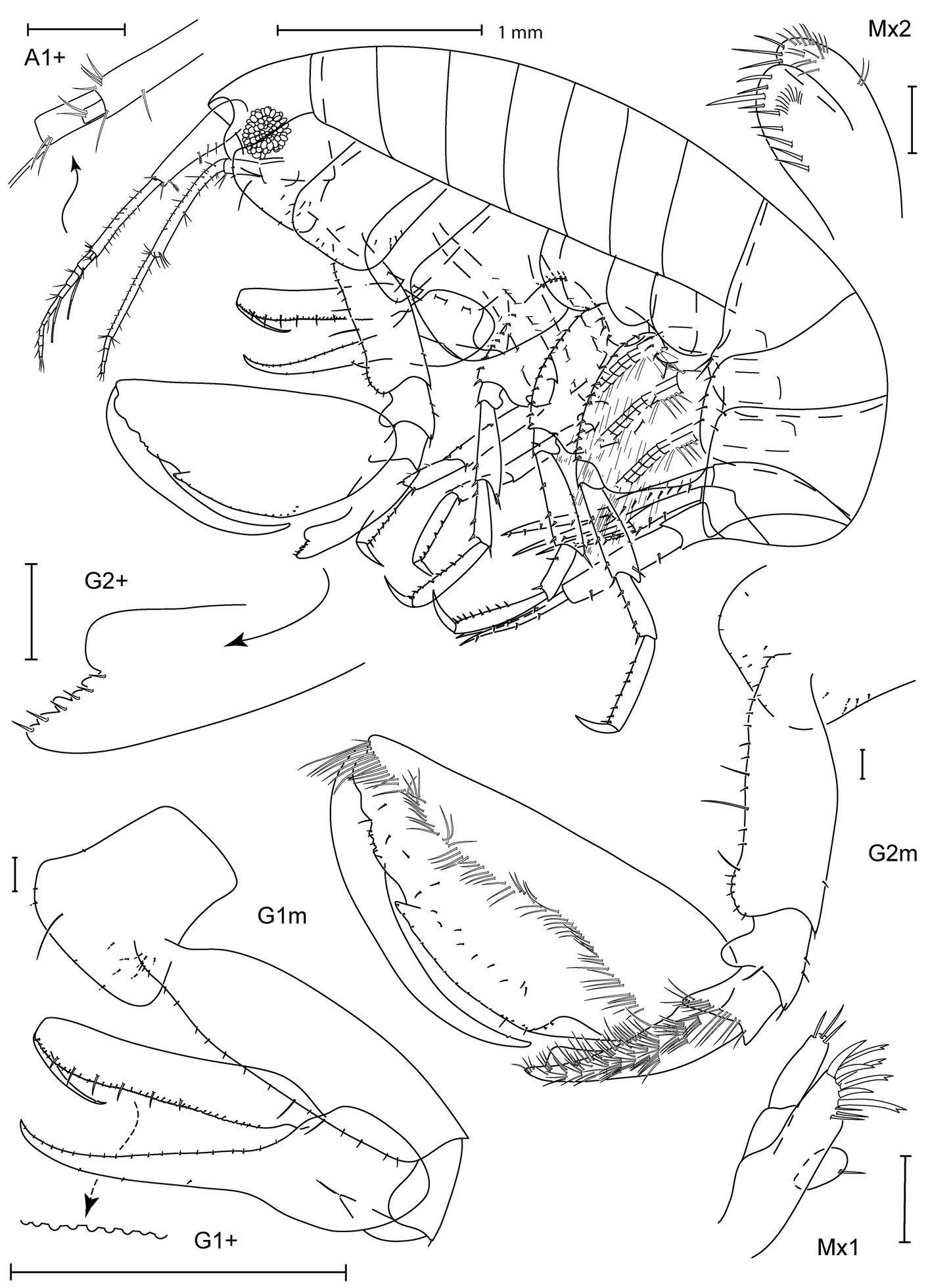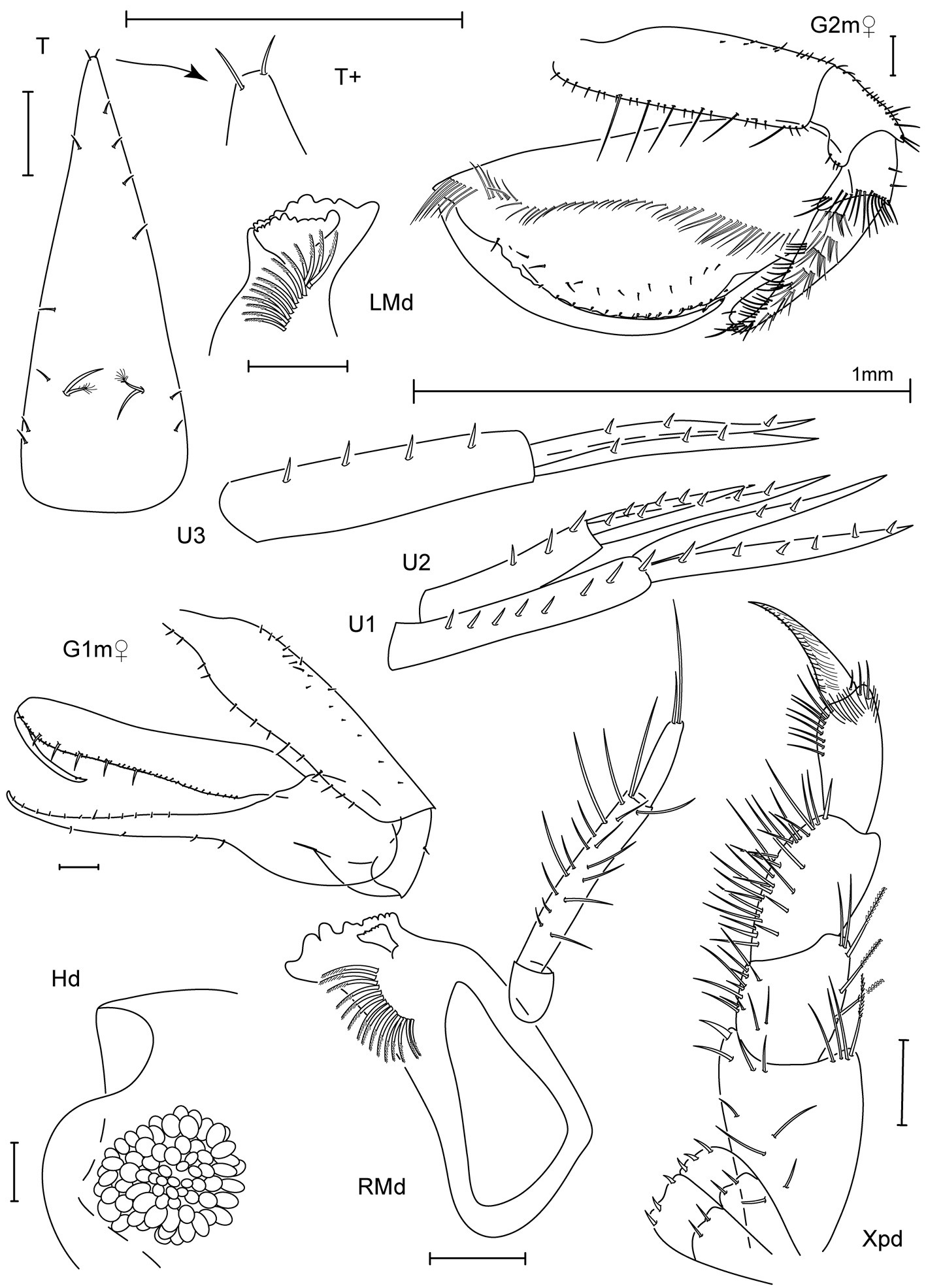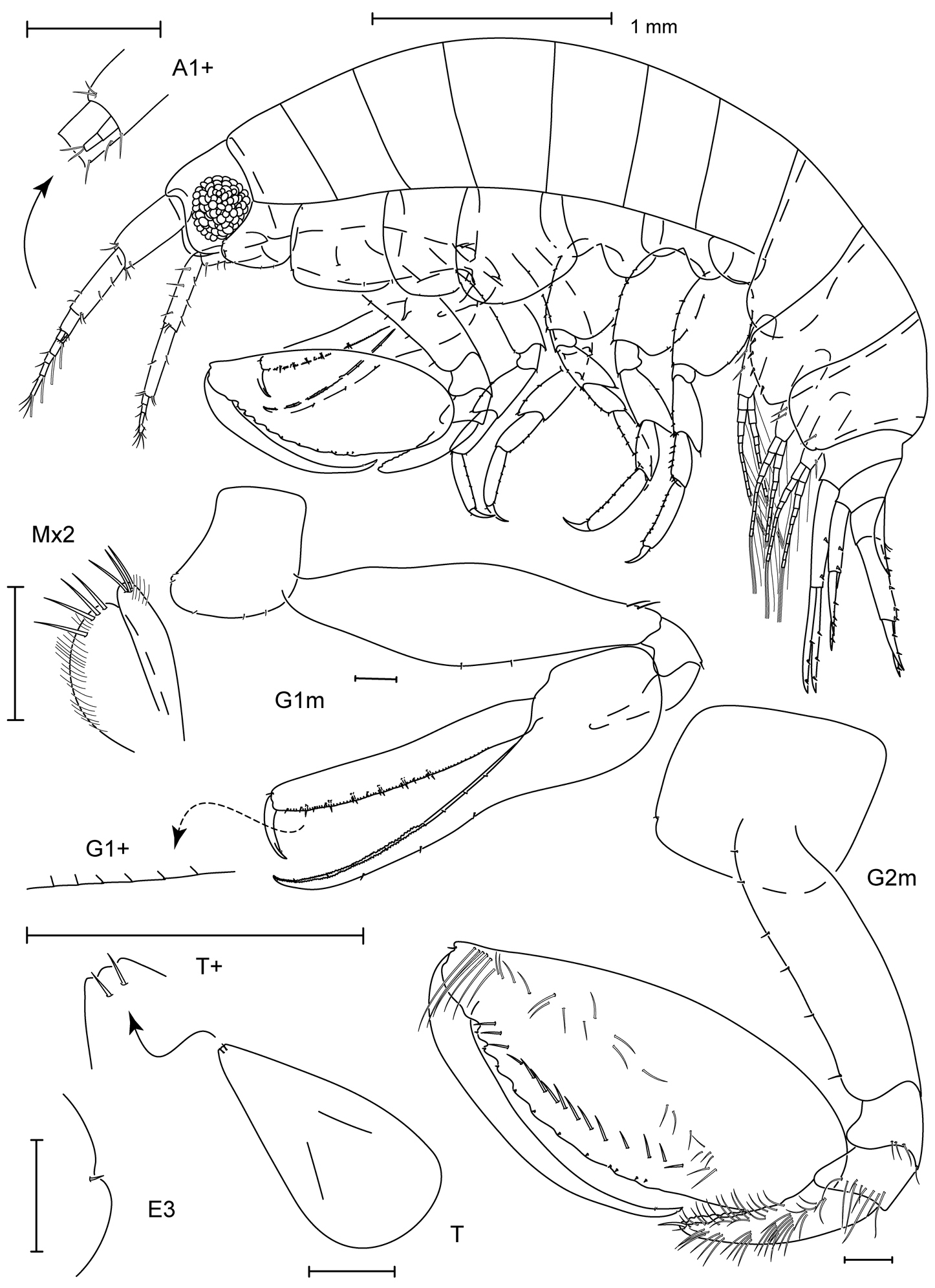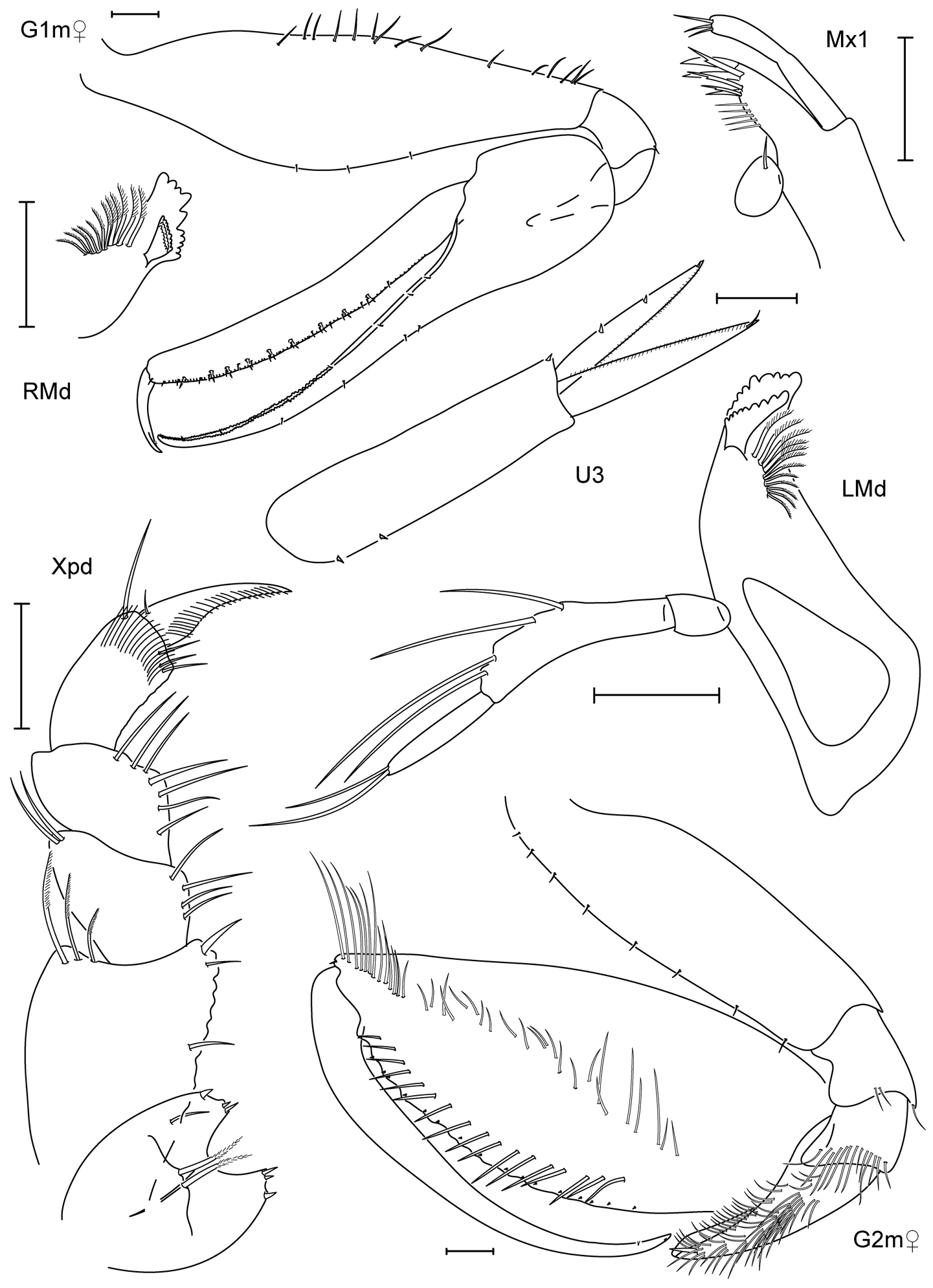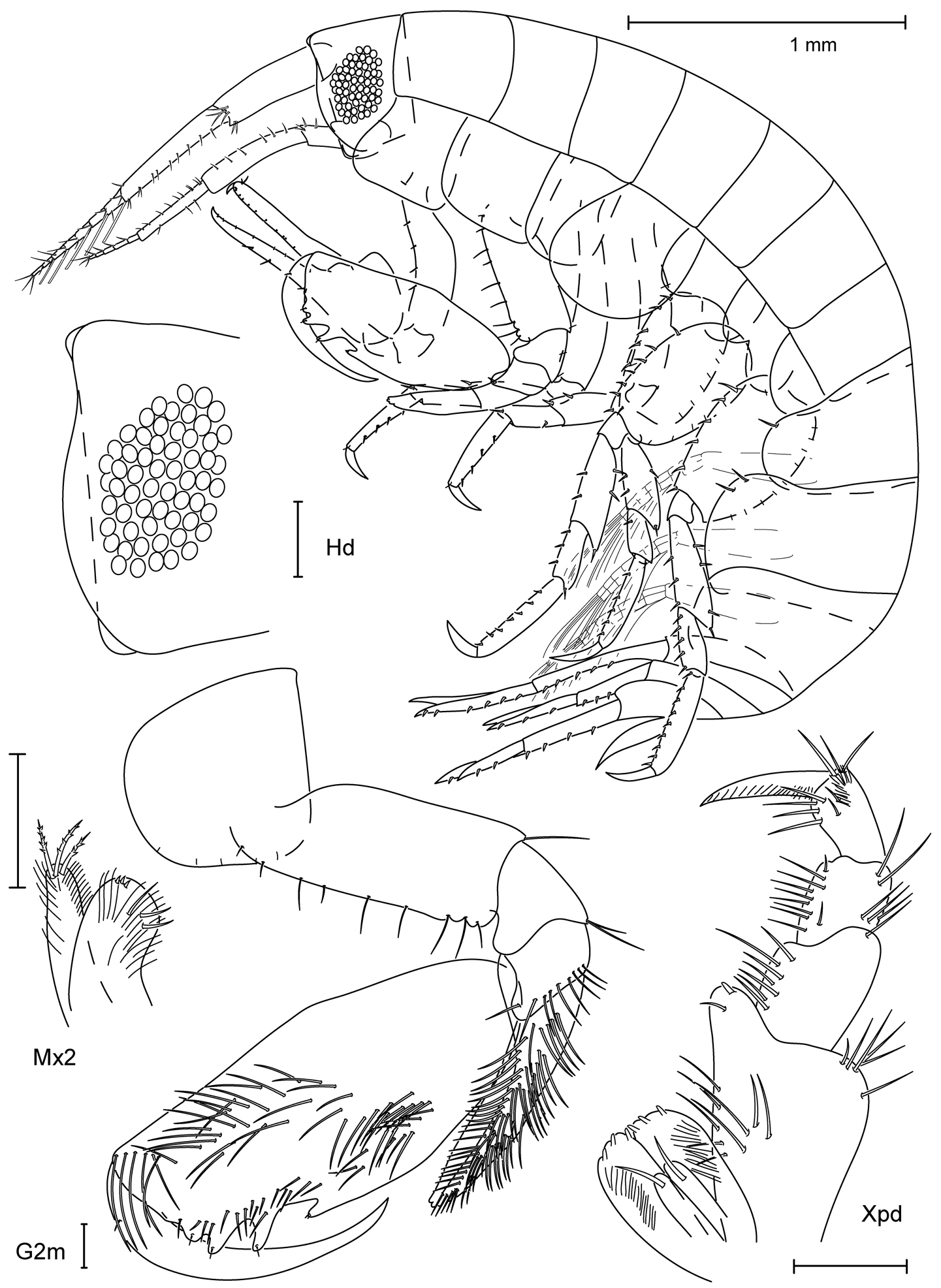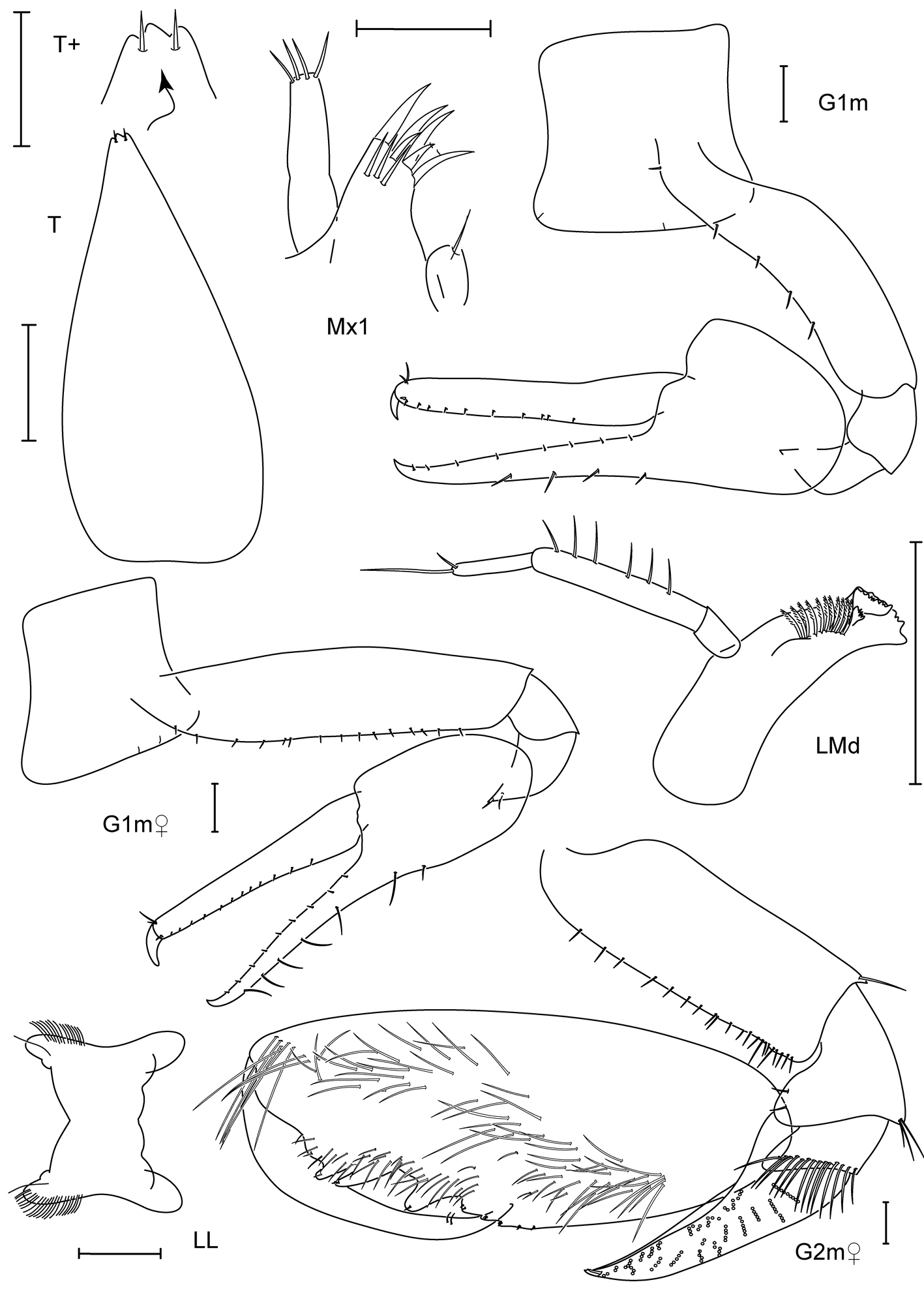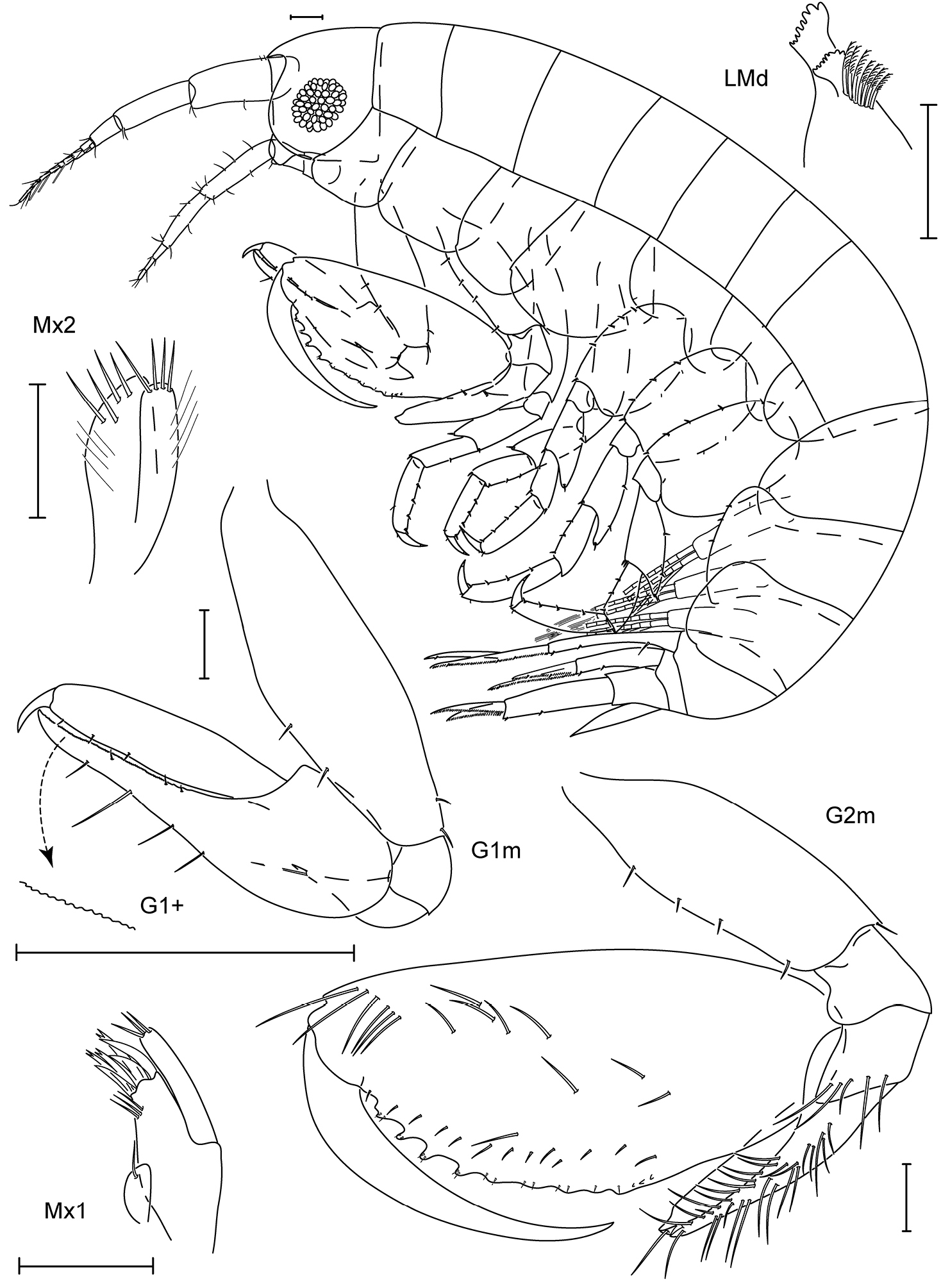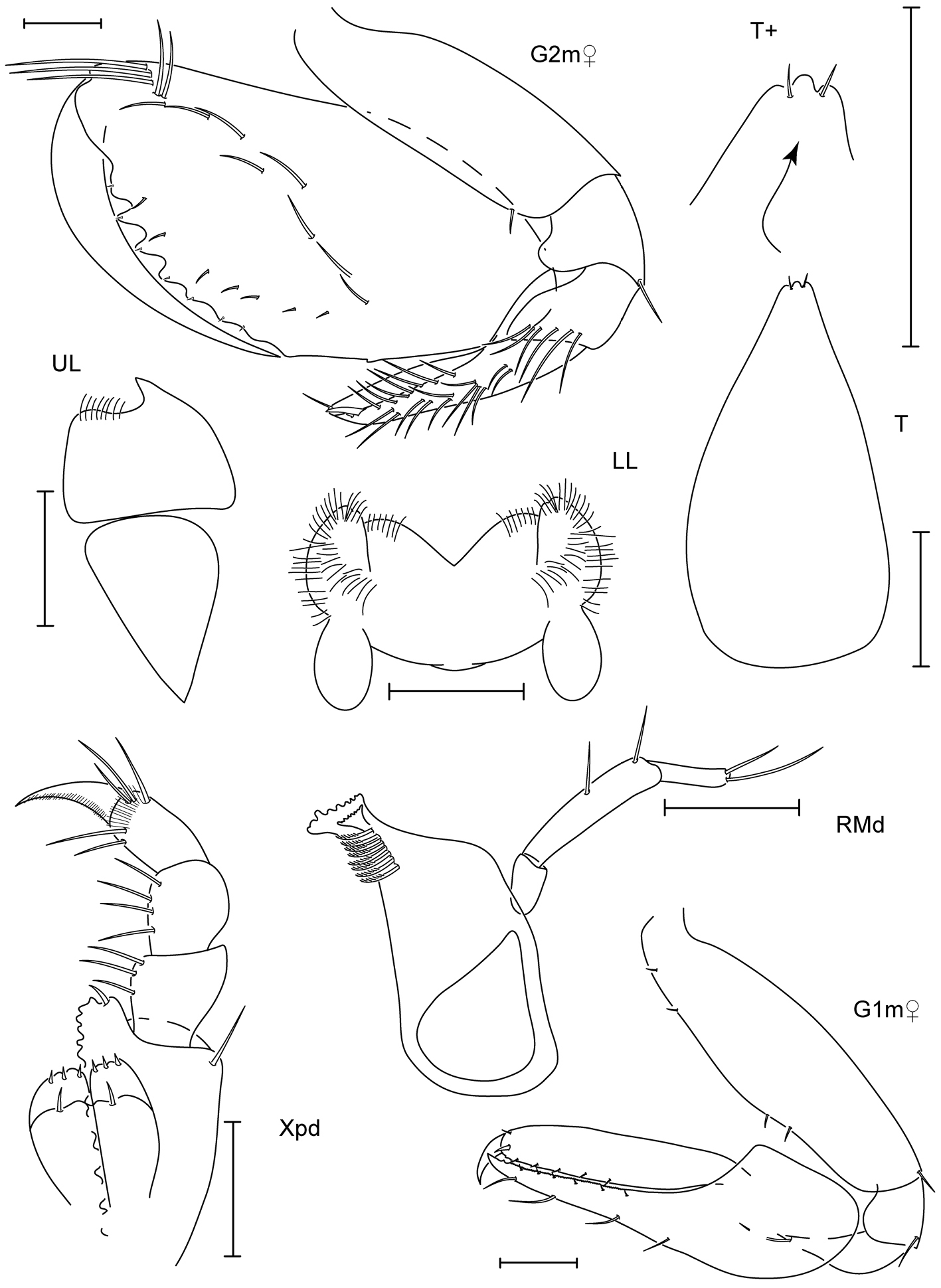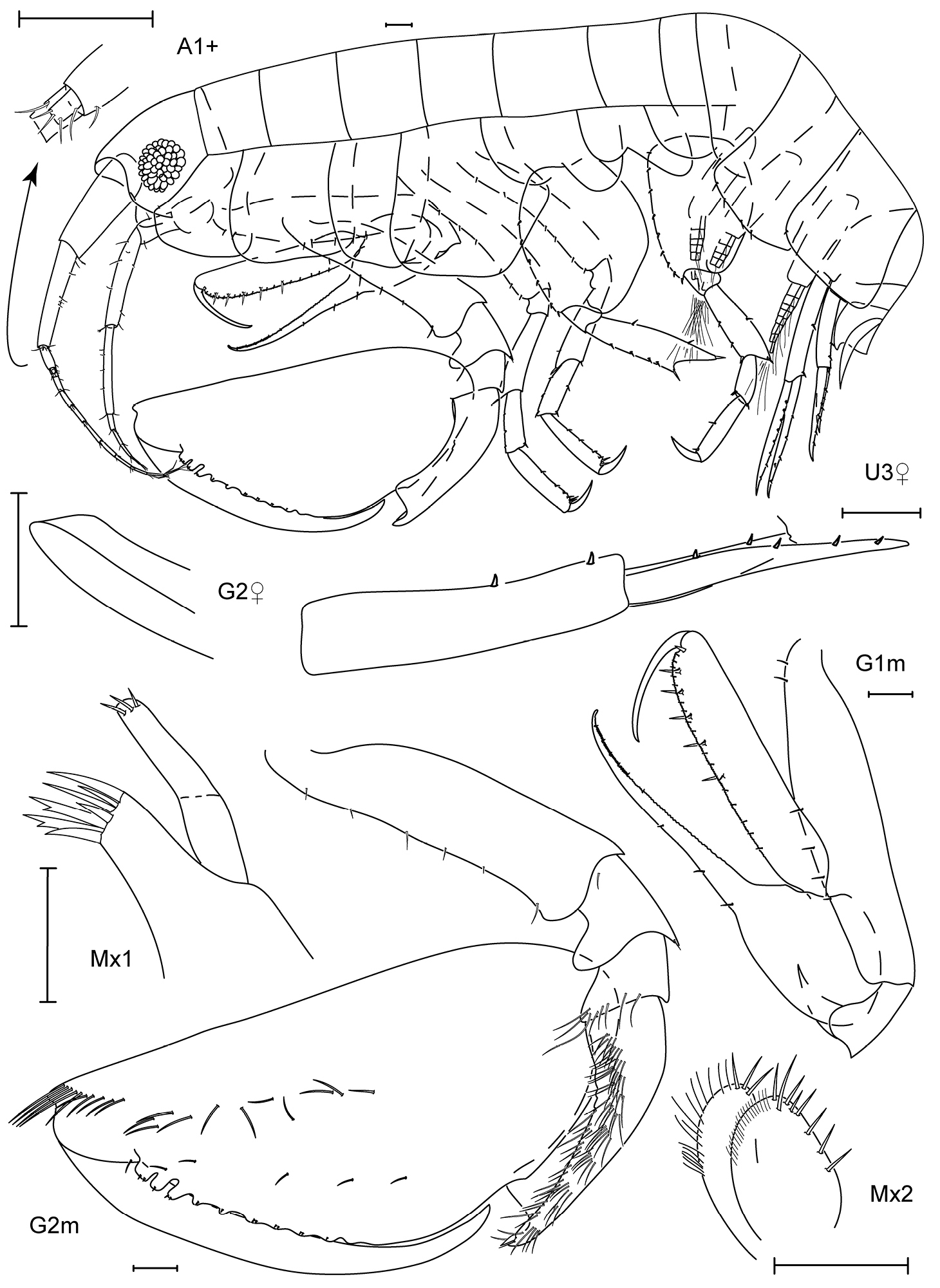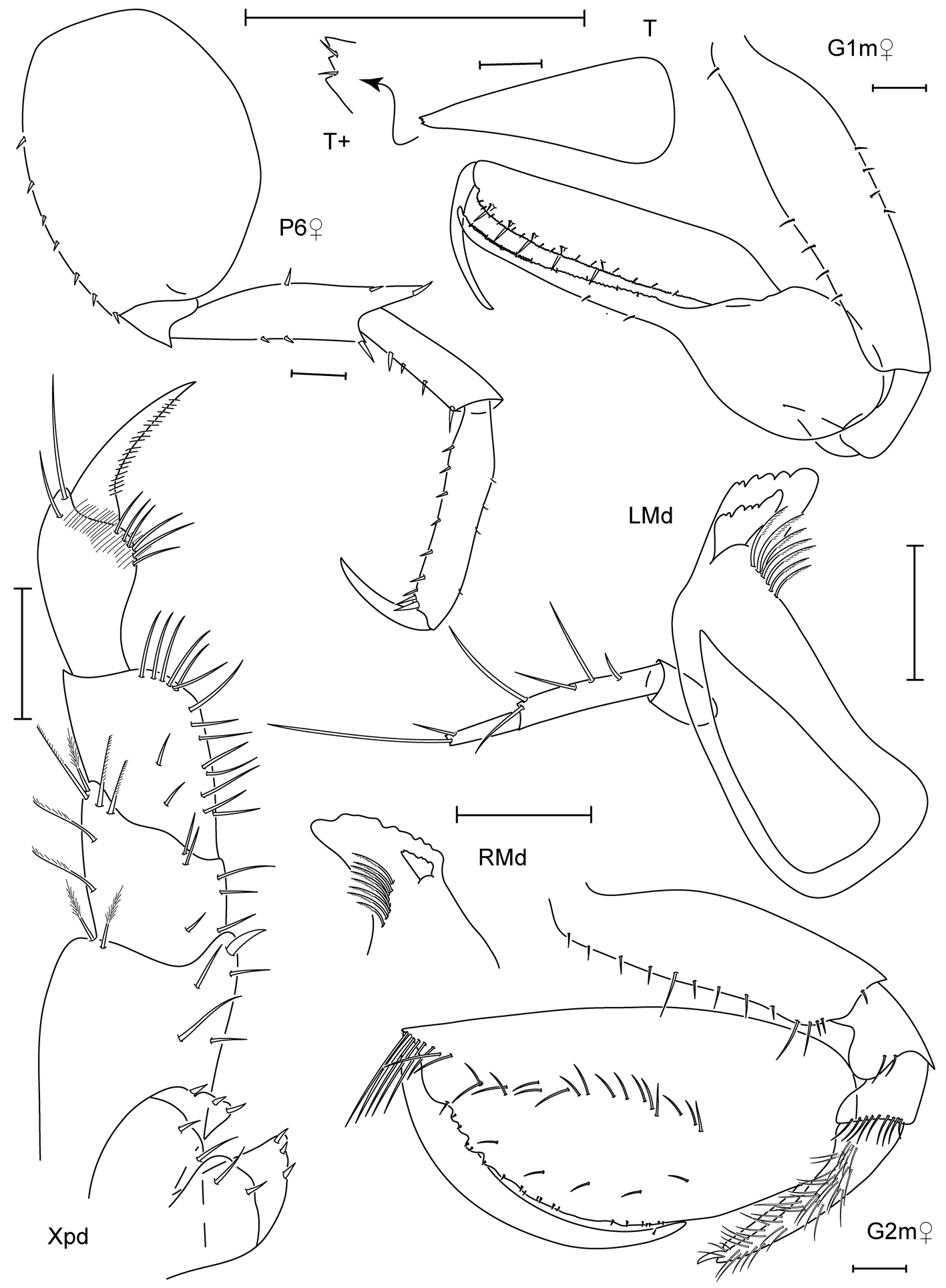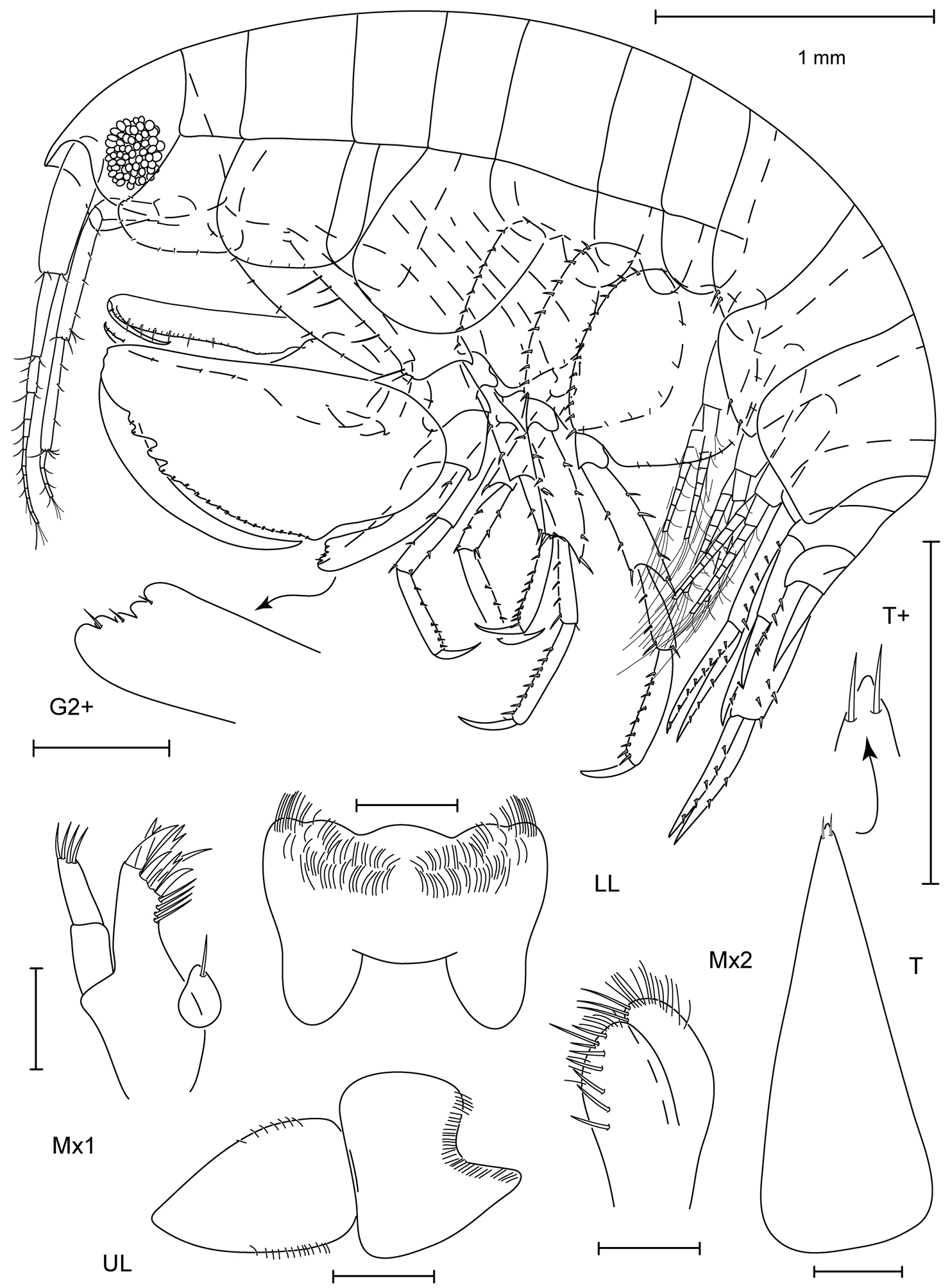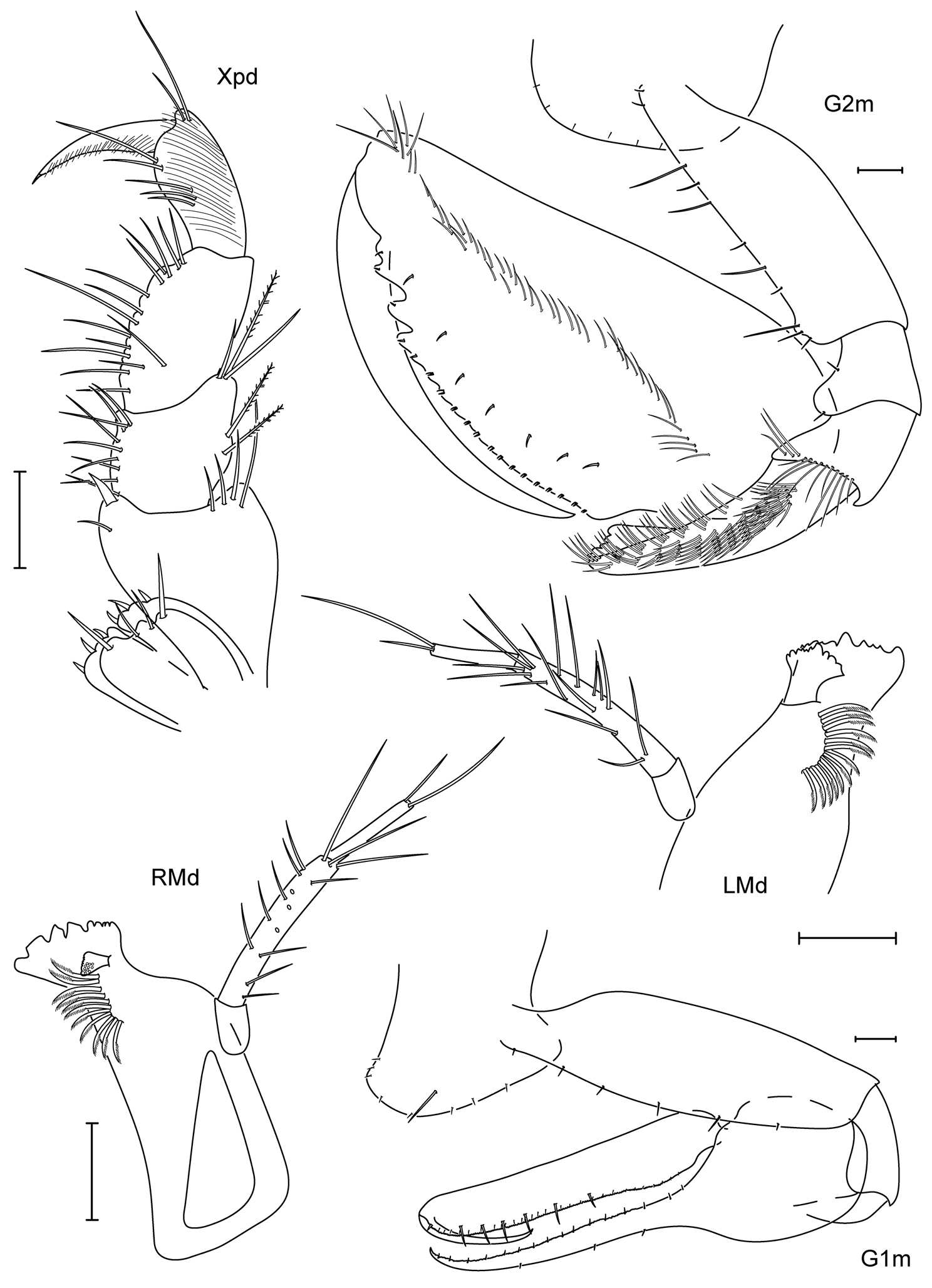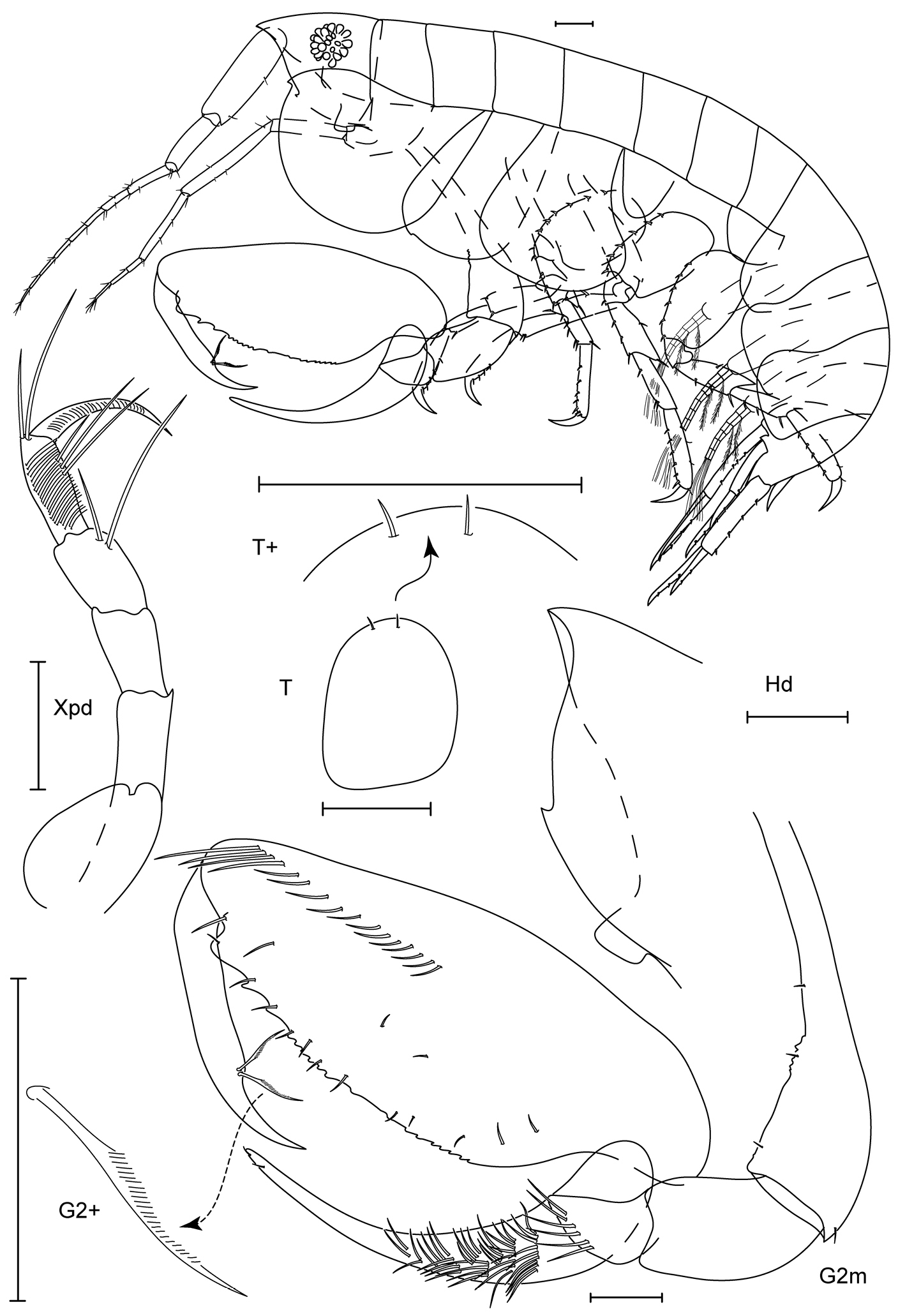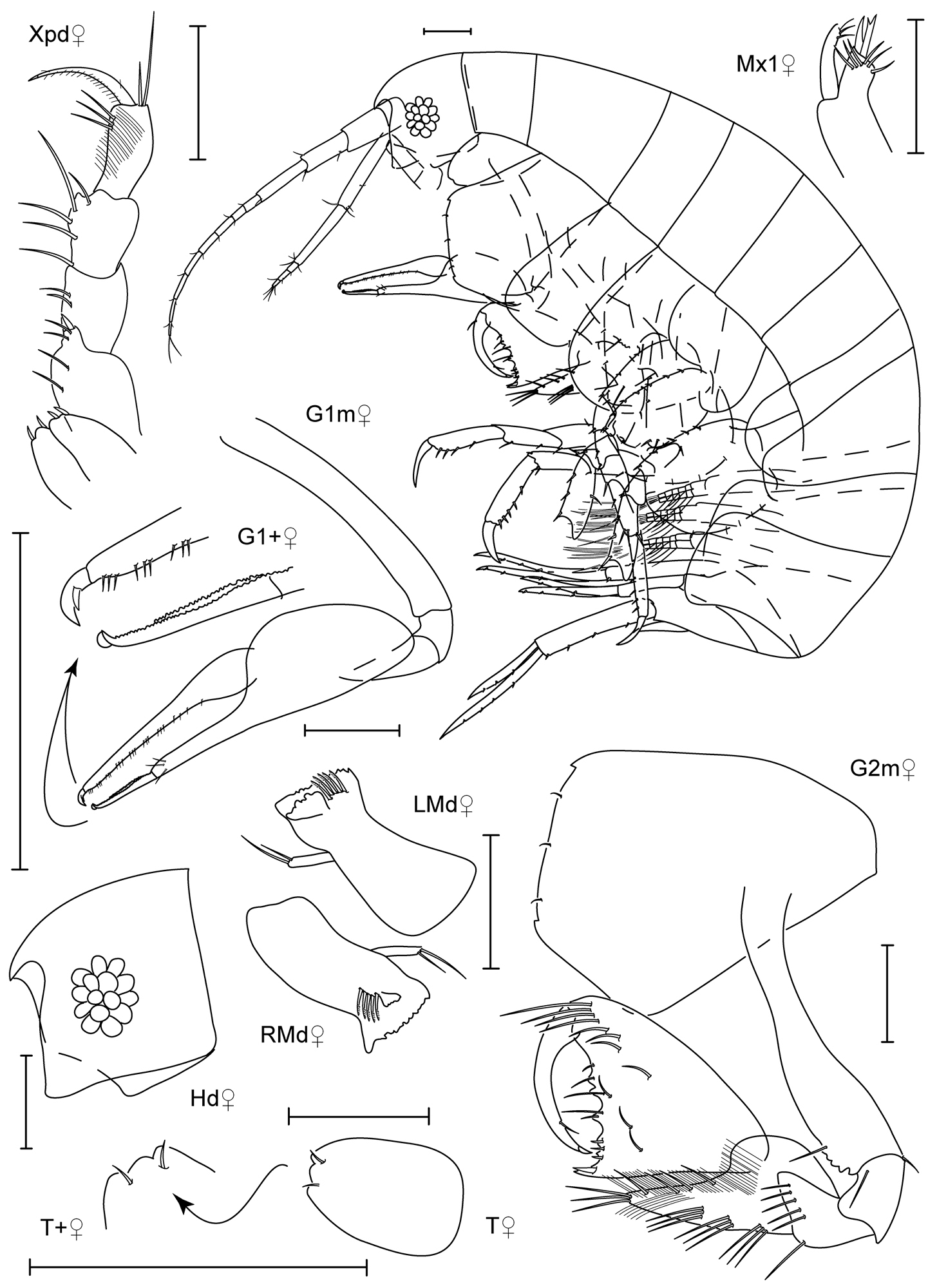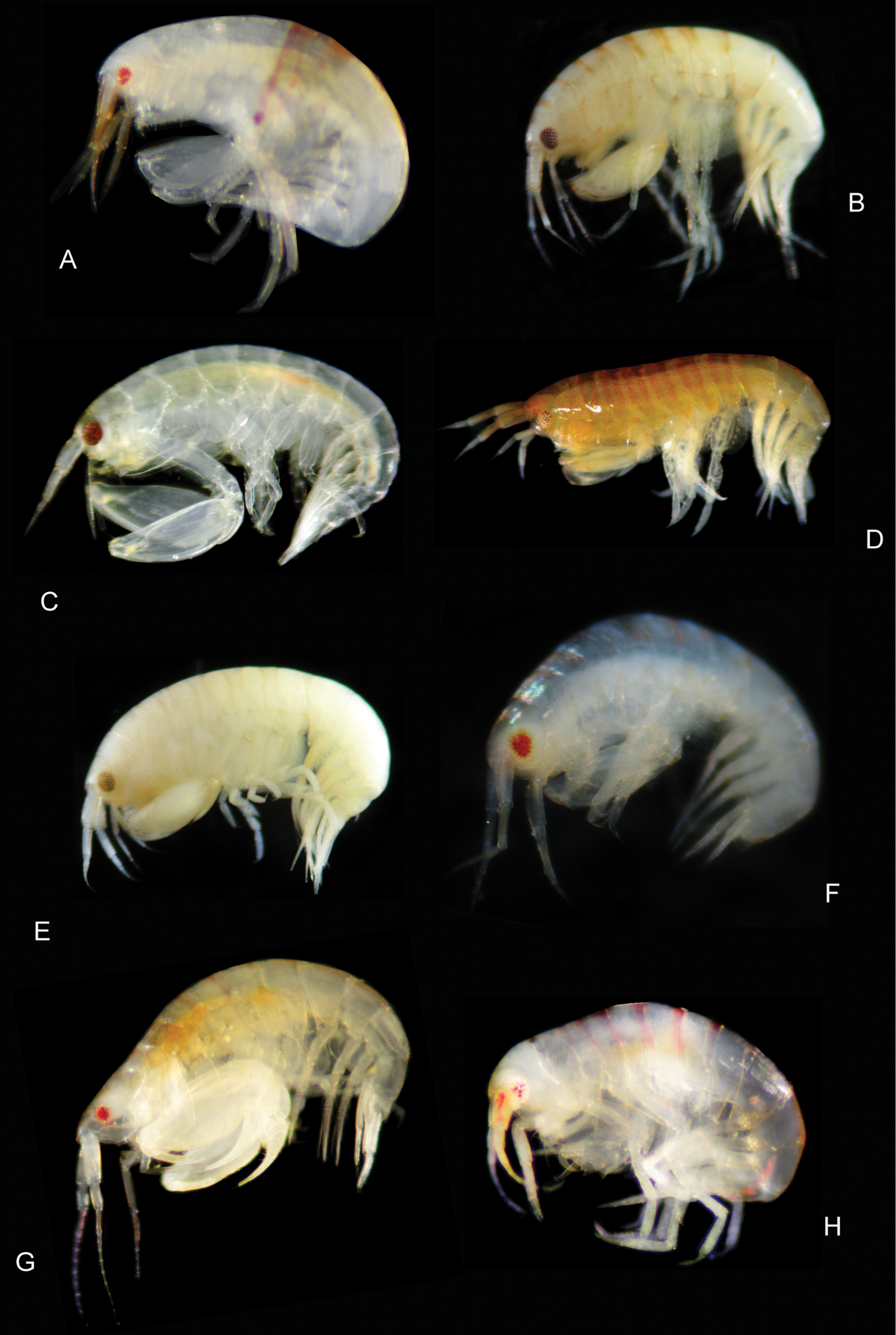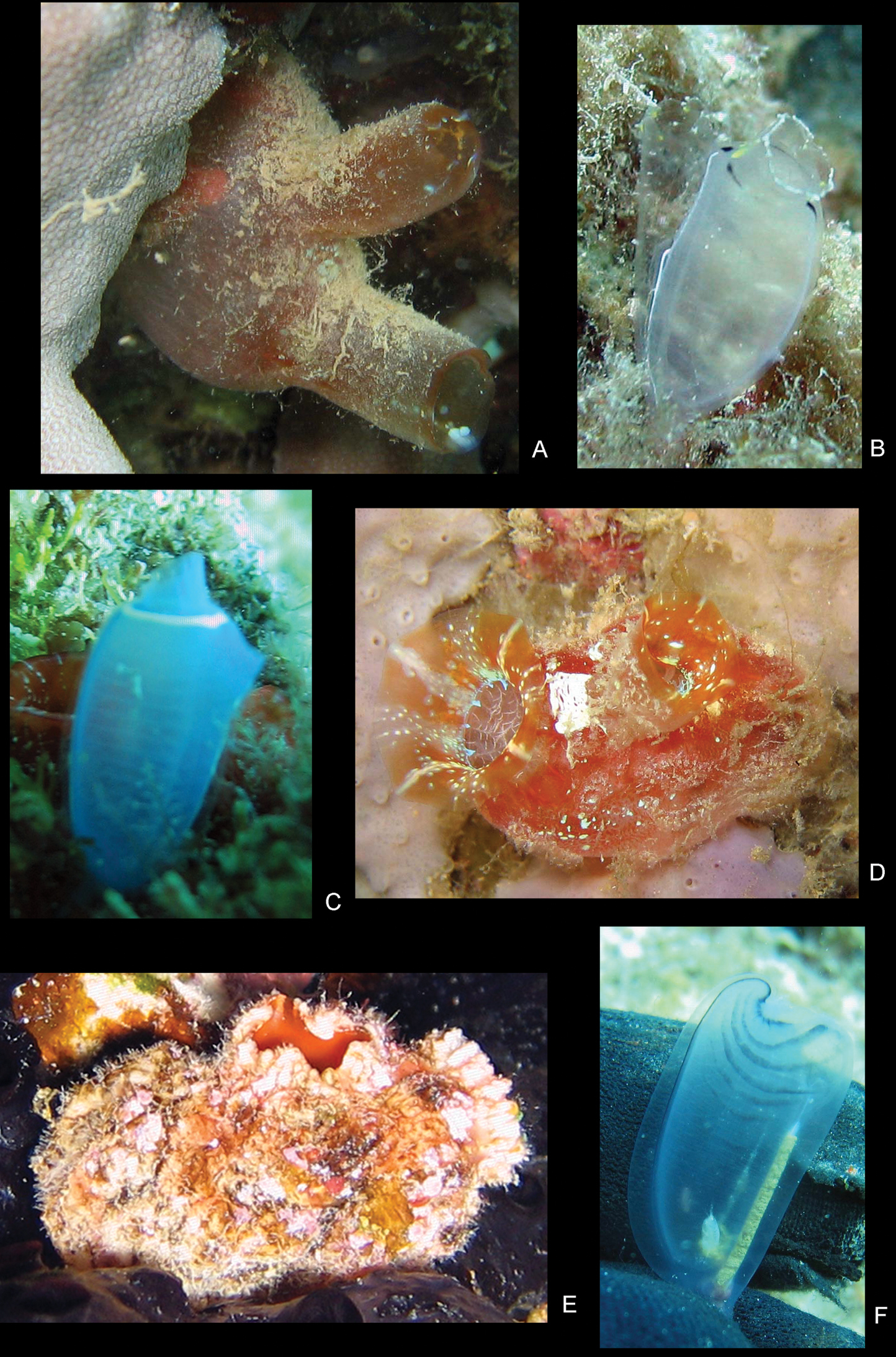






(C) 2012 Kristine N. White. This is an open access article distributed under the terms of the Creative Commons Attribution License 3.0 (CC-BY), which permits unrestricted use, distribution, and reproduction in any medium, provided the original author and source are credited.
For reference, use of the paginated PDF or printed version of this article is recommended.
Commensal leucothoid amphipods have been collected from the branchial chambers of their ascidian hosts throughout the Ryukyu Archipelago, Japan. Seven new species are described in two genera with valuable location data and host records. An identification key to ascidian-dwelling Leucothoidae of the Ryukyu Archipelago is provided.
Leucothoidae, Ryukyu, Okinawa, Japan, new species, commensal, Leucothoe amamiensis, Leucothoe elegans, Leucothoe nathani, Leucothoe obuchii, Leucothoe trulla, Leucothoe vulgaris, Paranamixis thomasi
The Leucothoidae are a family of marine gammaridean amphipods that can be found inhabiting sessile invertebrate hosts worldwide. The family currently contains 139 species in five genera and can be divided into two clades (
Leucothoids are typically found as endocommensal associates of sponges, ascidians or bivalve mollusks, where they utilize the feeding current produced by their hosts to feed. All genera exhibit extended parental care with members of the anamixid clade being potentially eusocial. Anamixids exhibit two of the three criteria for eusociality presented by
There are currently seven Leucothoidae species and one leucomorph reported from Japan (Anamixis sp. Hirayama, 1985 (leucomorph); Leucothoe alata (Barnard, 1959); Leucothoe bidens Hirayama, 1985; Leucothoe nagatai Ishimaru, 1985; Leucothoe pacifica Nagata, 1963; Leucothoe stylifera Stimpson, 1856; Paranamixis aberro Hirayama, 1983; Paranamixis misakiensis Thomas, 1997). The leucomorph is not connected to an anamorph and is, therefore, not considered a valid species (
The Ryukyu Archipelago consists of over 900 islands and islets between mainland Japan and Taiwan (Fig. 1) and is an area that has not been investigated for most amphipod families including leucothoids. The triple junction of the Philippine, Pacific, and Eurasian plates provides an interesting biogeographic study area, bringing together three potentially different sets of species.
Map of the Ryukyu Archipelago, Japan.
Specimens were collected via snorkeling and SCUBA at 47 locations throughout the Ryukyu Archipelago: Ishigaki–jima Island (4), Iriomote–jima Island (4), Okinawa–jima Island (21), Yoron–to Island (2), Okinoerabu–jima Island (2), Tokunoshima Island (4), Amami–oshima Island (6), and Yakushima Island (4) (Fig. 2). Table 1 lists the collection localities numbered in Fig. 2. Detailed station data are available in Supplementary Table 1. Whole ascidians were collected in zip-lock plastic bags and brought back to the laboratory. The ascidians were then dissected and commensal leucothoid amphipods were removed from the branchial chambers. Amphipods were preserved in 2% seawater buffered formalin for morphological analysis and 99% ethanol for molecular studies.
Map of collection localities in the Ryukyu Archipelago, Japan.
Collection localities numbered in Fig. 2.
| Southern Ryukyu Islands | |
| 1 | Kibura Bay, Ishigaki–jima Island, Okinawa |
| 2 | Sukoji Beach, Ishigaki–jima Island, Okinawa |
| 3 | Inoda Beach, Ishigaki–jima Island, Okinawa |
| 4 | Ibaruma, Ishigaki–jima Island, Okinawa |
| 5 | S of Hoshitate, Iriomote–jima Island, Okinawa |
| 6 | Channel between Iriomote–jima Island and Hatoma–jima Island, Okinawa |
| 7 | Blue Hole, Iriomote–jima Island, Okinawa |
| 8 | River drainage east of Funauki Port, Iriomote–jima Island, Okinawa |
| Central Ryukyu Islands | |
| 9 | Zanpa Cape, Okinawa–jima Island, Okinawa |
| 10 | Route 10 Bridge, Okinawa–jima Island, Okinawa |
| 11 | Hamahiga–jima Island, Okinawa |
| 12 | Maeda Point, Okinawa–jima Island, Okinawa |
| 13 | Toguchi Beach, Okinawa–jima Island, Okinawa |
| 14 | Mizugama, Okinawa–jima Island, Okinawa |
| 15 | Manza, Okinawa–jima Island, Okinawa |
| 16 | Sunabe Seawall, Okinawa–jima Island, Okinawa |
| 17 | Yona, Okinawa–jima Island, Okinawa |
| 18 | Zatsun, Okinawa–jima Island, Okinawa |
| 19 | Teniya Beach, Okinawa–jima Island, Okinawa |
| 20 | Odo, Okinawa–jima Island, Okinawa |
| 21 | Bise, Okinawa–jima Island, Okinawa |
| 22 | Chiribishi, Oura–wan Bay, Okinawa–jima Island, Okinawa |
| 23 | Kita–nakase, Oura–wan Bay, Okinawa–jima Island, Okinawa |
| 24 | Tettou–mae–oki, Oura–wan Bay, Okinawa–jima Island, Okinawa |
| 25 | Umi-saboten, Oura–wan Bay, Okinawa–jima Island, Okinawa |
| 26 | Teniya, Okinawa–jima Island, Okinawa |
| 27 | Uken, Kin Bay, Okinawa–jima Island, Okinawa |
| 28 | Shioya Bay, Okinawa–jima Island, Okinawa |
| 29 | Haneji Bay, Okinawa–jima Island, Okinawa |
| 30 | Ukatchi Coast, Yoron–to Island, Kagoshima |
| 31 | Shinaha Coast, Yoron–to Island, Kagoshima |
| 32 | Wanjo Beach, Okinoerabu–jima Island, Kagoshima |
| 33 | Naikina, Okinoerabu–jima Island, Kagoshima |
| 34 | Kaminomine, Tokunoshima Island, Kagoshima |
| 35 | Tete, Tokunoshima Island, Kagoshima |
| 36 | Omonawa, Tokunoshima Island, Kagoshima |
| 37 | San, Tokunoshima Island, Kagoshima |
| 38 | Shirahama Beach, Amami–oshima Island, Kagoshima |
| 39 | Kuse, Kakeroma–jima Island, Kagoshima |
| 40 | Sanakuiwa, Amami–oshima Island, Kagoshima |
| 41 | Boat dock, Amami–oshima Island, Kagoshima |
| 42 | Nominoura Oku, Kakeroma–jima Island, Kagoshima |
| 43 | Konase Kurosaki, Amami–oshima Island, Kagoshima |
| Northern Ryukyu Islands | |
| 44 | Kurio, Yakushima Island, Kagoshima |
| 45 | Yoshida, Yakushima Island, Kagoshima |
| 46 | Isso, Yakushima Island, Kagoshima |
| 47 | Haruta, Yakushima Island, Kagoshima |
Other sampling efforts included isolating entire sponges in zip-lock plastic bags for dissection in the laboratory or capturing amphipods individually in situ, using a modified squirt bottle. Coral rubble samples were also taken, elutriated, and sieved on location using both saltwater and formalin washes. Samples were sorted immediately and amphipods were preserved as previously stated.
Specimens used for morphological analyses were transferred to glycerin, dissected, mounted on slides, and illustrated using a Nikon® Y-IDT drawing tube attached to a Nikon® Eclipse 50I compound microscope. Pencil drawings were scanned and digitally inked in Adobe® Illustrator using a Wacom® Tablet, following the methods of
Descriptions are of males with sexually dimorphic characters described in a separate section. Terminology used in descriptions follows
Type material is deposited in The University of the Ryukyus Museum (Fujukan), with the prefix RUMF for museum numbers. Additional material has been deposited in The National Museum of Nature and Science in Tokyo, with the prefix NSMT for museum numbers.
Scale bars in figures represent 0.1 mm unless noted.
Figure legend: Hd, head; Mx, maxilla; Md, mandible; Xpd, maxilliped; LL, lower lip; UL, upper lip; G, gnathopod; P, pereopod; T, telson; U, uropod; L, left; R, right; l, lateral; m, medial; +, enlarged.
TaxonomyEyes, if present, generally well developed with 10 or more ocelli. Mandibles lacking molars, palp three articulate; right lacinia mobilis smaller than left. Maxilliped inner plates fused, palp 4–articulate; outer plates not reaching apex of palp article 1. Coxa 1–4 relatively equal in widths. Pereopods 5–7 bases generally expanded. Minimal to no sexual dimorphism.
urn:lsid:zoobank.org:act:33B0D200-A04A-4CA1-BFEA-5710AA382B05
http://species-id.net/wiki/Leucothoe_amamiensis
Figs 3, 4Holotype male, 5.9 mm, RUMF-ZC-1654, Sanakuiwa, Amami–oshima Island patch reef (28°06'58"N, 129°22'01"E), in branchial chamber of solitary ascidians, Pyura microcosmus (Savigny, 1816), 10 m, K.N. White, col., 19 March 2011 (KNWAmami2H). Paratype female, 4.7 mm, RUMF-ZC-1655, same station data as holotype.
Sanakuiwa, Amami–oshima Island, Japan (28°06'58"N, 129°22'01"E).
1 specimen, NSMT-Cr21813, KNWAmami2E; 3 specimens, RUMF-ZC-1656, KNWAmami2H; 10 specimens, RUMF-ZC-1657, KNWAmami3A; 33 specimens, NSMT-Cr21814, KNWAmami3C; 2 specimens, RUMF-ZC-1698, KNWAmami47J.
Mandibular palp article 2 with 17 setae. Right mandible lacinia mobilis with 2 distal rows of dentition. Coxae 1–4 with several short lateral facial setae. Gnathopod 1 coxa with 1 long medial facial seta. Gnathopod 2 basis anterior margin with 19 short and medium setae; carpus with large subdistal tooth; propodus mediofacial setal row displaced to palm. Epimeron 1 with anteroventral tuft of setae. Telson with plumose facial setae and simple marginal setae, apex truncate.
Head. Anterior margin rounded, anterodistal margin evenly rounded; ventral cephalic keel anterior margin excavate, anteroventral margin quadrate with a simple cusp, ventral margin oblique; eyes with more than 10 ommatidia, round. Antenna 1 0.3 × body length, flagellum 8–articulate, peduncle article 1 width less than 2 × article 2, accessory flagellum 1–articulate, aesthetascs present. Antenna 2 0.3 × body length, slightly shorter than antenna 1, flagellum 3–articulate. Mandibular palp ratio of articles 1–3 1.0: 3.5: 1.5, article 2 with 17 setae, article 3 with 2 distal setae, incisors strongly dentate; left mandible with 14 raker spines, lacinia mobilis large, strongly toothed; right mandible with 15 raker spines, lacinia mobilis small, weakly dentate, with 2 rows of dentition. Upper lip asymmetrically lobate, anterior margin setose. Lower lip inner lobes fused, bare; outer lobes with moderate gape, anterior margins setose. Maxilla 1 palp 2–articulate with 3 distal slender setae; outer plate with 7 distal robust setae and 3 distal slender setae. Maxilla 2 inner plate with 2 robust and 7 slender distal setae, short row of facial setae; outer plate with 11 distal marginal setae, facial setae present. Maxilliped inner plates distal margin with v-shaped indentation, with short robust setae; outer plate inner margin smooth, reaching 0.3 × palp article 1, with simple and setulate-serrate marginal setae, facial setae present; palp article 4 subequal in length with article 3, distally acute.
Pereon. Coxae 1–4 relative widths 1.0: 1.0: 0.7: 1.4. Gnathopod 1 coxa smooth, with tiny marginal setae, anterodistal margin produced, subquadrate, posterior margin excavate, medial and lateral facial setae present; basis distally expanded, anterior margin with 18 setae, posterior margin bare; ischium with 1 posterodistal seta; carpus linear, length 9.1 × width, proximal margin smooth, distal margin with 3 short setae; propodus straight, palm dentate with 6 proximal setae; dactylus smooth, reaching 0.3 × propodus length. Gnathopod 2 coxa longer than broad, subequal in length with coxa 3, smooth, with tiny marginal setae, anterodistally rounded, distal margin straight, posterior margin straight, lateral facial setae present; basis distally expanded with 3 small anterior tubercles, anterior margin with 19 short and medium setae, posterior margin with 2 short setae; ischium with posterior, distal, and posterodistal setae; carpus 0.3 × propodus length, curved, with large subdistal tooth, anterior margin smooth; propodus with 1 mediofacial setal row displaced to palm, reaching 0.8 × propodus length, with 1 row of submarginal setae, posterior margin smooth, palm convex with 3 small and 1 major tubercle, indentation near distal end of dactylus; dactylus curved, proximal margin smooth with 1 seta, anterior margin distally subacute, reaching 0.6 × propodus length. Pereopod 3 coxa length 1.8 × width, anterodistal corner overriding distal face of coxa 2, extending below it, smooth, with tiny marginal setae, anterior margin straight, distal margin oblique, posterior margin straight, lateral facial setae present. Pereopod 4 coxa smooth, with tiny marginal setae, anterior margin tapered, distal margin produced, posterior margin excavate, lateral facial setae present. Pereopods 5–7 coxae facial setae present; bases width length ratios 1: 1.4, 1: 1.3, 1: 1.3, posterior margins smooth, setose.
Pleon. Epimeron 1 with tuft of anteroventral setae, epimera 2–3 with ventral setae; epimeron 3 posteroventral corner subquadrate, produced. Uropods 1–3 relative lengths 1.0: 0.9: 1.1. Uropod 1 peduncle and outer ramus subequal in length with inner ramus; inner ramus with 6 robust setae; outer ramus with 2 robust setae. Uropod 2 peduncle 0.8 × inner ramus length; outer ramus 0.7 × inner ramus length; inner ramus with 5 robust setae; outer ramus with 3 robust setae. Uropod 3 peduncle 1.1 × inner ramus length; outer ramus subequal in length with inner ramus; inner and outer rami each with 3 robust setae. Telson 2.7 × longer than wide, with plumose facial setae and simple marginal setae, apex truncate.
Gnathopod 1 basis proximally expanded, anterior margin with 13 short setae, posterior margin with 16 short posterior setae; ischium with posterior seta; carpus distal margin with 4 short setae; propodus palm with 5 proximal setae. Gnathopod 2 basis without tubercles, anterior margin with 26 short and long setae, posterior margin with 12 short setae; ischium with 14 posterior setae, 3 anterior setae, and 2 posterodistal setae; carpus with small subdistal tooth; propodus palm with small tubercles.
Leucothoe amamiensis sp. n., holotype male, 5.9 mm, RUMF-ZC-1654.
Leucothoe amamiensis sp. n., holotype male, 5.9 mm, RUMF-ZC-1654; paratype female, 4.7 mm, RUMF-ZC-1655.
After ‘Amami’ and referring to the type locality of this species.
In branchial chamber of solitary ascidians, Rhopalaea circula Monniot & Monniot, 2001 (Fig. 18F); Pyura microcosmus (Fig. 18D); and coral rubble.
Leucothoe amamiensis is similar to Leucothoe commensalis Haswell, 1879, Leucothoe wuriti Thomas and Klebba, 2007, Leucothoe epidemos White and Thomas, 2009, and Leucothoe thula White and Thomas, 2009 in having a rounded head, single seta on the medial surface of coxa 1, a long gnathopod 1 dactylus, and a displaced gnathopod 2 mediofacial setal row. It is similar to Leucothoe articulosa Montagu, 1804, Leucothoe incisa (Robertson, 1893), and Leucothoe procera (Bate, 1857) in having gnathopod 2 carpus with a large subapical tooth. Leucothoe amamiensis is similar to Leucothoe occulta Krapp-Schickel, 1975 in having coxae with facial setae. Leucothoe amamiensis differs from these species in having two rows of dentition on the right mandibular lacinia mobilis, a heavily setose gnathopod 2 basis, and a telson with plumose facial setae and simple marginal setae, and truncate apex.
Leucothoe amamiensis has a pink-orange striped color pattern (Fig. 17B). This species appears to be endemic to Amami–oshima Island.
East China Sea: Amami–oshima Island, Kagoshima, Japan.
urn:lsid:zoobank.org:act:9113E46D-8259-463F-BBF9-9BBB2FAA5ED4
http://species-id.net/wiki/Leucothoe_elegans
Figs 5, 6Holotype male, 4.5 mm, RUMF-ZC-1658, Isso, Yakushima Island patch reef (30°27'29"N, 130°29'22"E), in grey-purple hard sponge, 10–12 m, K.N. White, col., 27 May 2011 (KNWYaku3A). Paratype female, 5.7 mm, RUMF-ZC-1659, same station data as holotype.
Type locality. Isso, Yakushima Island, Japan (30°27'29"N, 130°29'22"E).
8 specimens, NSMT-Cr21815, KNWYaku3B; 4 specimens, RUMF-ZC-1660, KNWYaku3L; 3 specimens, RUMF-ZC-1661, KNWYaku5C; 3 specimens, RUMF-ZC-1662, KNWOkinawa54A; 16 specimens, NSMT- Cr 21816, KNWOkinawa54I; 2 specimens, RUMF-ZC-1699, KNWOkinawa54I.
Diagnosis (male). Mandibular palp article 2 robust, with 4 setae. Right mandible lacinia mobilis distal margin with 3 rows of dentition. Maxilliped outer plate inner margin tuberculate. Eye large, covering most head. Gnathopod 1 basis proximally widened; carpus elongate. Gnathopod 2 propodus with one submarginal row of robust setae; dactylus proximal margin with 2 setae, distal margin with spine; epimeron 3 posteroventral margin with small sinus.
Head. Anterior margin truncate, anterodistal margin evenly rounded; ventral cephalic keel anterior margin transverse, anteroventral margin rounded, ventral margin straight; eyes with more than 10 ommatidia, large, round. Antenna 1 0.2 × body length, flagellum 6–articulate, peduncle article 1 width less than 2 × article 2, accessory flagellum 2–articulate. Antenna 2 0.2 × body length, subequal in length with antenna 1, flagellum 4–articulate. Mandibular palp ratio of articles 1–3 1.0: 3.5: 1.6, article 2 robust with 4 setae, article 3 with 2 distal setae, incisors strongly dentate; left mandible with 12 raker spines, lacinia mobilis large, strongly toothed; right mandible with 12 raker spines, lacinia mobilis small, weakly dentate, with 3 rows of dentition. Upper lip asymmetrically lobate, anterior margin bare. Lower lip inner lobes fused, setose, with facial setae; outer lobes with moderate gape, anterior margins setose. Maxilla 1 palp 1–articulate with 3 distal setae; outer plate with 6 distal robust setae and 5 distal slender setae. Maxilla 2 inner plate with 3 robust distal setae and 5 slender distal setae; outer plate with 4 robust distal marginal setae and 21 marginal setae. Maxilliped inner plates distal margin with arc-shaped indentation, with short robust setae and long plumose setae; outer plate inner margin tuberculate, reaching 0.2 × palp article 1, inner plate plumose marginal setae; palp article 4 subequal in length with article 3, distally acute.
Pereon. Coxae 1–4 relative widths 1.0: 1.6: 1.4: 1.7. Gnathopod 1 coxa smooth, with tiny marginal setae, anterodistal margin produced, subquadrate with cusp, distal margin rounded, posteroventral margin narrowly rounded, facial setae absent; basis centrally expanded, anterior margin with 2 short setae, posterior margin with 2 medium setae; ischium bare; carpus linear, length 14.2 × width, proximal margin dentate, distal margin with 3 short setae; propodus curved, palm dentate with 6 distal setae; dactylus with linear striation and 1 short seta, reaching 0.2 × propodus length. Gnathopod 2 coxa broader than long, subequal to coxa 3, smooth, with tiny marginal setae, anterior margin expanded anteriorly with cusp, anterodistally subquadrate, distal margin straight, posterior margin straight, facial setae absent; basis distally expanded, anterior margin with 6 short setae, posterior margin bare; ischium with 3 distal setae and 1 posterodistal seta; carpus 0.3 × propodus length, curved, distally tapered, anterior margin dentate; propodus with 1 mediofacial setal row displaced to palm, reaching 0.7 × propodus length, with 1 row of robust submarginal setae, posterior margin smooth, palm convex with 4 major tubercles; dactylus curved, proximal margin smooth with 2 setae, distal margin with 1 tooth, anterior margin distally acute, reaching 0.7 × propodus length. Pereopod 3 coxa length 1.1 × width, anterodistal corner overriding distal face of coxa 2, extending below it, smooth, with tiny marginal setae, anterior margin expanded, distal margin slightly convex with cusps, posterior margin straight, facial setae absent. Pereopod 4 coxa smooth, with tiny marginal setae, anterior margin produced with cusp, distal margin evenly rounded, posterior margin excavate, facial setae absent. Pereopods 5–7 coxae facial setae absent; bases oval, width length ratios 1: 1.3, 1: 1.4, 1: 1.4; posterior margins serrate, setose.
Pleon. Epimera 1–2 with ventral setae, epimeron 3 bare; epimeron 3 posteroventral corner with small sinus, subquadrate. Uropods 1–3 relative lengths 1.0: 0.7: 0.7; inner and outer rami lined with short marginal setae. Uropod 1 peduncle and outer ramus subequal in length with inner ramus; inner and outer rami each with 3 robust setae. Uropod 2 peduncle 0.9 × inner ramus length; outer ramus 0.8 × inner ramus length; inner and outer rami each with 2 robust setae. Uropod 3 peduncle 1.5 × inner ramus length; outer ramus 0.9 × inner ramus length; inner and outer rami each with 2 robust setae. Telson 1.9 × longer than wide, without facial or marginal setae, apex very weakly tridentate.
Gnathopod 1 basis anterior margin with 3 short setae, posterior margin with 15 medium setae; ischium with 1 posterodistal seta; carpus distal margin with 4 short setae; propodus palm with 9 distal setae. Gnathopod 2 propodus with longer robust submarginal setae.
. Leucothoe elegans sp. n., holotype male, 4.5 mm, RUMF-ZC-1658.
Leucothoe elegans sp. n., holotype male, 4.5 mm, RUMF-ZC-1658; paratype female, 5.7 mm, RUMF-ZC-1659.
After the Latin ‘elegans’, meaning tasteful, choice, fine, and referring to the elegant, elongate gnathopod 1 of males and females of this species.
In branchial chamber of solitary ascidian, Rhopalaea circula (Fig. 18F); grey/purple hard sponge; dark red chimney sponge; orange flame sponge; purple brown soft sponge; and orange stubby sponge.
Leucothoe elegans is similar to Leucothoe germanalcyone Hirayama, 1992 in having an enlarged eye; similar to Leucothoe flammosa Thomas and Klebba, 2007 and Leucothoe uschakovi Gurjanova, 1951 in having an elongate gnathopod 1 with a centrally widened basis; and similar to Leucothoe nagatai in having short antennae, narrow pereopod 5–7 bases, and a sinuous epimeron 3. Leucothoe elegans differs from these species in having a dentate right mandible lacinia mobilis, female gnathopod 1 with many posterior setae, and gnathopod 2 propodus with submarginal row of robust setae.
Leucothoe elegans is translucent ivory in color (Fig. 17C). This species has only been collected on Yakushima Island and from Shioya Bay, on the east coast of Okinawa–jima Island, Okinawa.
East China Sea: Okinawa–jima Island, Okinawa and Yakushima Island, Kagoshima, Japan.
urn:lsid:zoobank.org:act:ECB34479-0D69-4027-8604-CE98C89F809B
http://species-id.net/wiki/Leucothoe_nathani
Figs 7, 8Holotype male, 4.8 mm, RUMF-ZC-1663, Mizugama reef wall (26°21'35"N, 127°44'22"E), in branchial chamber of solitary ascidian, Herdmania of Lahille, 1888, 7–9 m, N.S. White col., 26 February 2011 (KNWOkinawa34J). Paratype female, 6.3 mm, RUMF-ZC-1664, same station data as holotype.
Mizugama, Okinawa, Japan (26°21'35"N, 127°44'22"E).
2 specimens, RUMF-ZC-1665, KNWOkinawa34J; 1 specimen, KNWOkinawa42G.
Maxilla 1 palp 1–articulate, margins constricted. Maxilliped outer plate reaching 0.4 × length of palp article 1. Male gnathopod 1 basis posterodistally expanded; carpus basally inflated; dactylus very short, reaching 0.1 × propodus length. Gnathopod 2 propodus mediofacial setal row very robust with tufts of setae, palm with 4 long tubercles and 1 large indentation.
Head. Anterior margin rounded, anterodistal margin evenly rounded; ventral cephalic keel anterior margin excavate, anteroventral margin subquadrate, ventral margin straight; eyes with more than 10 ommatidia, oval. Antenna 1 0.3 × body length, flagellum 6–articulate, peduncle article 1 width less than 2 × article 2, accessory flagellum absent, aesthetascs present. Antenna 2 0.3 × body length, subequal in length with antenna 1, flagellum 5–articulate. Mandibular palp ratio of articles 1–3, 1.0: 3.8: 1.8, article 2 with 6 setae, article 3 with 2 distal setae, incisors strongly dentate; left mandible with 10 raker spines, lacinia mobilis large, strongly toothed; right mandible with 9 raker spines, lacinia mobilis small, weakly dentate. Upper lip asymmetrically lobate, anterior margin setose. Lower lip inner lobes fused, bare; outer lobes with moderate gape, anterior margins setose. Maxilla 1 palp 1–articulate, margins constricted, with 4 distal setae; outer plate with 6 distal robust setae and 3 distal slender setae. Maxilla 2 inner plate with 3 short distal robust setae, 3 distal slender setae, and facial setae; outer plate 3 distal serrate robust setae, 7 marginal slender setae, and facial setae. Maxilliped inner plates distal margin with v-shaped indentation, with short robust setae and long setae, with facial setae; outer plate inner margin smooth, reaching 0.4 × length of palp article 1, with 6 distal setae and 1 distal robust seta, facial setae present; palp article 4 elongate, distally acute.
Pereon. Coxae 1–4 relative widths 1.0: 1.0: 0.8: 1.4. Gnathopod 1 coxa smooth, with tiny marginal setae, anterodistal corner produced, subtriangular, distal margin straight, posterior margin excavate, facial setae absent; basis posterodistally expanded, anterior margin with 5 short setae, posterior margin bare; ischium bare; carpus basally inflated, length 7.6 × width, proximal margin smooth, distal margin with 4 medium setae; propodus straight, palm smooth with 10 distal setae; dactylus smooth, reaching 0.1 × propodus length. Gnathopod 2 coxa equally as long as broad, subequal in length with coxa 3, smooth, with tiny marginal setae, anterodistally rounded, distal margin straight, posterior margin straight, facial setae absent; basis distally expanded, stout, with 3 small anterodistal tubercles, anterior margin with 9 short-medium length setae, posterior margin with 1 seta; ischium with 2 posterodistal setae; carpus 0.4 × propodus length, straight, distally tapered, anterior margin dentate; propodus with 1 mediofacial setal row displaced to palm, reaching 0.7 × propodus length, with 1 row of submarginal setae, posterior margin smooth, palm convex with 4 major tubercles; dactylus recurved, proximal margin smooth, bare, anterior margin distally acute, reaching 0.5 × propodus length. Pereopod 3 coxa length 1.4 × width, anterodistal corner overriding distal face of coxa 2, not extending below it, smooth, bare, anterior margin straight, distal margin oblique, posterior margin straight, facial setae absent. Pereopod 4 coxa smooth, bare, anterior margin produced, distal margin evenly rounded, posterior margin tapered, facial setae absent. Pereopod 5 coxa facial seta present, pereopods 6–7 coxae facial setae absent; bases oval, width length ratios 1:1.6, 1:1.6, 1:1.5, posterior margins smooth, setose.
Pleon. Epimera 1–2 with ventral setae, epimeron 3 bare; epimeron 3 posteroventral corner rounded. Uropods 1–3 relative lengths 1.0: 0.6: 0.8; inner and outer rami lined with short marginal setae. Uropod 1 peduncle 1.1 × inner ramus length; outer ramus subequal in length with inner ramus; inner ramus with 6 robust seate; outer ramus with 3 robust setae. Uropod 2 peduncle 0.7 × inner ramus length; outer ramus 0.8 × inner ramus length; inner ramus with 1 robust seta; outer ramus with 3 robust seate. Uropod 3 peduncle 1.4 × inner ramus length; outer ramus subequal in length with inner ramus; inner and outer rami each with 1 robust seta. Telson 2.2 × longer than wide, apex weakly tridentate.
Gnathopod 1 basis anterior margin with 15 short setae; carpus linear, distal margin with 7 longer setae. Gnathopod 2 basis anterior margin with 21 short setae; carpus anterior margin smooth; dactylus with two proximal setae.
Leucothoe nathani sp. n., holotype male, 4.8 mm, RUMF-ZC-1663.
Leucothoe nathani sp. n., holotype male, 4.8 mm, RUMF-ZC-1663; paratype female, 6.3 mm, RUMF-ZC-1664.
Named for Nathan Stuart White, amphipod collector extraordinaire, who collected the type specimens of this species. Nathan has provided tremendous support and assistance throughout all sampling efforts in the Ryukyu Archipelago.
In branchial chamber of solitary ascidian, Herdmania (Fig. 18A) and compound ascidian, Clavelina of Savigny, 1816 (Fig. 18C).
Leucothoe nathani is similar to Leucothoe nagatai in having short antennae, an elongate maxilliped outer plate inner margin, a short gnathopod 1 dactyl, a heavily setose gnathopod 2 propodus medial surface, and narrow pereopod 5-7 bases. This species differs in having a smooth maxilliped outer plate inner margin, slenderner gnathopod 1 carpus (length 7.6 × width compared to length 6.6 × width in Leucothoe nagatai), and a longer telson (2.2 × longer than wide compared to 1.8 × longer than wide in Leucothoe nagatai).
Leucothoe nathani is orange in color with robust dark orange stripes along pereonites (Fig. 17D). This species has been collected from only one location in February and April, two of the coldest months on Okinawa–jima Island.
East China Sea: Okinawa–jima Island, Japan.
urn:lsid:zoobank.org:act:590FEF5F-1261-4F6E-B4F5-07B7940CD81B
http://species-id.net/wiki/Leucothoe_obuchii
Figs 9, 10Holotype male, 4 mm, RUMF-ZC-1666, Tettou–mae–oki, Oura–wan Bay (26°32'43"N, 128°02'56"E), muddy sand slope, in branchial chamber of solitary ascidian Rhopalaea of Phillippi, 1843 (clear with black and yellow lines), 24 m, M. Obuchi, col., 4 March 2011 (KNWOkinawa37A). Paratype female, 3.8 mm, RUMF-ZC-1667, same station data as holotype.
Tettou–mae–oki, Oura–wan Bay, Okinawa, Japan (26°32'43"N, 128°02'56"E).
5 specimens, RUMF-ZC-1668, KNWAmami3F; 2 specimens, NSMT-Cr21817, KNWOkinawa48A; 2 specimens, NSMT –Cr21818, KNWYaku3K; 1 specimen, NSMT –Cr21819, KNWYaku5N.
Maxilla 1 palp 1–articulate. Maxilliped outer plate inner margin tuberculate, reaching 0.7 × palp article 1. Gnathopod 1 basis centrally widened; carpus with 4 long distal setae; propodus inflated; dactylus short, reaching 0.2 × propodus length. Pereopods 5–7 bases narrow, oval; epimeron 3 posteroventral margin with small sinus.
Head. Anterior margin rounded, anterodistal margin evenly rounded; ventral cephalic keel anterior margin transverse, anteroventral margin rounded, ventral margin excavate; eyes with more than 10 ommatidia, oval. Antenna 1 0.3 × body length, flagellum 7–articulate, peduncle article 1 width less than 2 × article 2, accessory flagellum 1–articulate, aesthetascs present. Antenna 2 0.2 × body length, shorter than antenna 1, flagellum 3–articulate. Mandibular palp ratio of articles 1–3 1.0: 2.5: 1.2, article 2 and 3 each with 2 distal setae, incisors strongly dentate; left mandible with 7 raker spines, lacinia mobilis large, strongly toothed; right mandible with 8 raker spines, lacinia mobilis small, weakly dentate. Upper lip asymmetrically lobate, anterior margin setose. Lower lip inner lobes fused, setose; outer lobes with moderate gape, anterior margins setose, with facial setae. Maxilla 1 palp 1–articulate with 3 distal setae; outer plate with 6 distal robust setae and 3 distal slender setae. Maxilla 2 inner plate with 4 distal and 4 marginal setae; outer plate with 5 robust distal setae and 4 marginal setae. Maxilliped inner plates distal margin with v-shaped indentation, with short robust setae; outer plate inner margin tuberculate, reaching 0.7 × palp article 1, with 1 simple distal seta; palp article 4 subequal in length with article 3, distally acute.
Pereon. Coxae 1–4 relative widths 1.0: 1.5: 1.2: 1.8. Gnathopod 1 coxa smooth, bare, anterodistal corner produced, subquadrate with cusp, distal margin straight, posterior margin excavate, facial setae absent; basis centrally widened, anterior margin with 2 short setae, posterior margin with 2 short setae; ischium bare; carpus linear, length 7.1 × width, proximal margin dentate, distal margin with 4 long setae; propodus curved, slightly inflated, palm smooth with 3–5 distal setae; dactylus smooth, reaching 0.2 × propodus length. Gnathopod 2 coxa broader than long, subequal to coxa 3, smooth, bare, anterodistally rounded, distal margin straight, posterior margin straight, facial setae absent; basis distally expanded, anterior margin with 4 setae, posterior margin bare; ischium bare; carpus 0.4 × propodus length, straight, distally tapered, anterior margin with indentation; propodus with 1 mediofacial setal row displaced below midline, reaching 0.7 × propodus length, with 1 row of submarginal setae, posterior margin smooth, palm convex with 4 major tubercles; dactylus curved, proximal margin smooth, bare, anterior margin distally acute, reaching 0.4 × propodus length. Pereopod 3 coxa length 1.2 × width, anterodistal corner overriding distal face of coxa 2, extending below it, smooth, bare, anterior margin expanded, distal margin straight, posterior margin straight, facial setae absent. Pereopod 4 coxa smooth, bare, anterior margin tapered with cusp, distal margin evenly rounded, posterior margin tapered, facial setae absent. Pereopods 5–7 coxae facial setae absent; bases oval, width length ratios 1: 1.5, 1: 1.5, 1:1.5, posterior margins smooth, setose.
Pleon. Epimeron 1 bare; epimera 2–3 with ventral setae; epimeron 3 posteroventral corner slightly sinuous, rounded. Uropods 1–3 relative lengths 1.0: 0.7: 0.7; inner and outer rami lined with short marginal setae. Uropod 1 peduncle and outer ramus subequal in length with inner ramus; inner ramus with 1 robust seta; outer ramus with 3 robust setae. Uropod 2 peduncle subequal in length with inner ramus; outer ramus 0.8 × inner ramus length; inner ramus with 1 robust seta; outer ramus with 2 robust setae. Uropod 3 peduncle 1.4 × inner ramus length; outer ramus 0.8 × inner ramus length; inner and outer rami without robust setae. Telson 1.9 × longer than wide, apex weakly tridentate.
Gnathopod 1 basis anterior margin with 4 setae, posterior margin with 1 posterodistal seta. Gnathopod 2 basis anterior margin with 1 seta; carpus anterior margin smooth.
Leucothoe obuchii sp. n., holotype male, 4.0 mm, RUMF-ZC-1666.
Leucothoe obuchii sp. n., holotype male, 4.0 mm, RUMF-ZC-1666; paratype female, 3.8 mm, RUMF-ZC-1667.
Named for “General” Masami Obuchi, who collected the type specimens of this species. Dr. Obuchi has provided invaluable sampling and logistical support for this research in the Ryukyu Archipelago.
In branchial chamber of solitary ascidians, Rhopalaea (Fig. 18B) and Rhopalaea circula (Fig. 18F); and coral rubble.
Leucothoe obuchii is similar to Leucothoe nagatai in having short antennae, an elongate tuberculate maxilliped outer plate inner margin, a short gnathopod 1 dactyl, and narrow pereopod 5-7 bases. This species differs in having a much less setose gnathopod 2 propodus medial surface. Leucothoe nagatai has robust tufts of mediofacial setae covering most of the proximal surface of the propodus compared to single mediofacial and submarginal setal rows in Leucothoe obuchii.
Leucothoe obuchii is opaque ivory in color (Fig. 17E). In most collections of this species there was one specimen at the base of the branchial chamber of each ascidian collected. Rarely, there were one large and one small amphipod living together.
East China Sea: Okinawa–jima Island (Okinawa), Tokunoshima Island, Amami–oshima Island, and Yakushima Island (all Kagoshima), Japan.
urn:lsid:zoobank.org:act:211A291A-EBDE-47F1-86F6-3BE9D376049D
http://species-id.net/wiki/Leucothoe_trulla
Figs 11, 12Holotype male, 4.3 mm, RUMF-ZC-1669, Inoda Beach patch reef (24°27'46"N, 124°15'13"E), coral rubble, K.N. White col. 20 April 2011 (KNWIshigaki3G). Paratype female, 4.4 mm, RUMF-ZC-1670, same station data as holotype.
Inoda Beach, Ishigaki, Japan (24°27'46"N, 124°15'13"E).
2 specimens, RUMF-ZC-1671, KNWIriomote4A; 3 specimens, NSMT –Cr21820, KNWIshigaki3G.
Maxilla 1 palp 1–articulate, margins constricted. Gnathopod 1 coxa posterior margin distally serrate. Gnathopod 2 coxa distal margin serrate; carpus distally truncate, spoon-like; propodus mediofacial setal row displaced to midline.
Head. Anterior margin rounded, anterodistal margin evenly rounded; ventral cephalic keel anterior margin excavate, anteroventral margin rounded with an anteriorly projecting cusp, ventral margin straight; eyes with more than 10 ommatidia, round. Antenna 1 0.4 × body length, flagellum 10–articulate, peduncle article 1 width less than 2 × article 2, accessory flagellum 1–articulate, aesthetascs present. Antenna 2 0.3 × body length, shorter than antenna 1, flagellum 5–articulate. Mandibular palp ratio of articles 1–3, 1.0: 2.7: 1.4, article 2 with 5–6 setae, article 3 with 2 distal setae, incisors weakly dentate; left mandible with 7 raker spines, lacinia mobilis large, strongly toothed; right mandible with 7 raker spines, lacinia mobilis small, weakly dentate. Upper lip asymmetrically lobate, anterior margin setose. Lower lip inner lobes fused, bare; outer lobes with moderate gape, anterior margins setose. Maxilla 1 palp 1–articulate, margins constricted, with 3 distal setae; outer plate with 7 distal robust setae. Maxilla 2 inner plate with 5 distal setae, 3 marginal setae, and facial setae; outer plate with 4 robust distal setae and 15 marginal setae. Maxilliped inner plates distal margin with v-shaped indentation, with short robust setae and short setae; outer plate inner margin smooth, reaching 0.2 × length of palp article 1, with simple and plumose marginal setae, facial setae absent; palp article 4 subequal in length with article 3, distally acute.
Pereon. Coxae 1–4 relative widths 1.0: 1.3: 1.1: 1.8. Gnathopod 1 coxa smooth, with tiny marginal setae, smooth, anterodistal margin produced, subquadrate with cusp, distal margin straight, posterior margin excavate, distally serrate, facial setae absent; basis linear, anterior margin with 6 setae, posterior margin bare; ischium bare; carpus linear, length 19.8 × width, proximal margin dentate, distal margin with 3 short setae; propodus straight, palm dentate with 5 distal setae; dactylus smooth, reaching 0.4 × propodus length. Gnathopod 2 coxa longer than broad, subequal to coxa 3, smooth, with tiny marginal setae, distal margin serrate, anterodistally rounded, distal margin straight, posterior margin straight, facial setae absent; basis distally expanded, anterior margin with 6 short setae, posterior margin bare; ischium bare; carpus 0.3 × propodus length, curved, distally truncate, spoon-like, anterior margin smooth; propodus with 1 slightly displaced mediofacial setal row, reaching 0.6 × propodus length, with 1 row of submarginal setae, posterior margin smooth, palm convex with 3 major and 2 minor tubercles; dactylus curved, proximal margin smooth, bare, anterior margin distally subacute, reaching 0.7 × propodus length. Pereopod 3 coxa length 1.3 × width, anterodistal corner overriding distal face of coxa 2, extending below it, smooth, bare, anterior margin straight, distal margin oblique, posterior margin straight, facial setae absent. Pereopod 4 coxa smooth, bare, anterior margin straight, distal margin evenly rounded, posterior margin excavate, facial setae absent. Pereopods 5–7 coxae facial setae absent; bases slightly posteriorly tapered, width length ratios 1: 1.3, 1: 1.3, 1: 1.4; posterior margins smooth, bare.
Pleon. Epimera 1–3 with ventral setae; epimeron 3 posteroventral corner rounded. Uropods 1–2 relative lengths 1.0: 0.8. Uropod 1 peduncle 0.9 × inner ramus length; outer ramus 0.9 × inner ramus length; inner ramus with 5 robust seta; outer ramus with 8 robust setae. Uropod 2 peduncle 0.9 × inner ramus length; outer ramus 0.7 × inner ramus length; inner and outer rami each with 4 robust setae. Uropod 3 missing. Telson 2.3 × longer than wide, apex weakly tridentate.
Gnathopod 1 basis anterior margin with 5 setae, posterior margin with 4 setae; carpus distal margin with 2 short setae. Gnathopod 2 basis anterior margin with 13 short and medium setae; ischium with 2 distal setae; carpus truncate, not spoon-like; propodus palm with smaller tubercles. Uropod 3 peduncle 0.7 × inner ramus length; outer ramus broken; inner and outer rami with robust setae.
Leucothoe trulla sp. n., holotype male, 4.3 mm, RUMF-ZC-1669; paratype female, 4.4 mm, RUMF-ZC-1670.
Leucothoe trulla sp. n., holotype male, 4.3 mm, RUMF-ZC-1669; paratype female, 4.4 mm, RUMF-ZC-1670.
After the Latin ‘trulla’, meaning ‘stirring spoon, skimmer’ and referring to the spoon-like carpus on male gnathopod 2.
In branchial chamber of solitary ascidian, Herdmania (Fig. 18A); and coral rubble.
Leucothoe trulla is similar to Leucothoe commensalis, Leucothoe wuriti, Leucothoe epidemos, and Leucothoe thula. The members of this “Leucothoe commensalis group” share a rounded head, long gnathopod 1 dactylus, a displaced gnathopod 2 propodus mediofacial setal row, and wide pereopod 5-7 bases. This species is also similar to Leucothoe alata, Leucothoe dentata Ledoyer, 1973, Leucothoe denticulata Costa, 1853, Leucothoe epidemos, Leucothoe lihue Barnard, 1970, Leucothoe rudicula White and Thomas, 2009, and Leucothoe tolkieni Vinogradov, 1990 in having a spoon-like gnathopod 2 carpus. This species differs from all of these species in having a ventral cephalic keel with an excavate anterior margin; constricted margins on the maxilla 1 palp, a serrate coxa 1 posteroventral margin; a serrate distal coxa 2 margin; and a rounded epimeron 3 posteroventral corner.
Leucothoe trulla has faint pink-red stripes along pereonite edges and a slightly darker “saddleback” color in the middle (Fig. 17F). This species is endemic to the southern Ryukyu Islands.
East China Sea: Ishigaki–jima Island and Iriomote–jima Island, Okinawa, Japan.
urn:lsid:zoobank.org:act:C8E57473-2175-403A-93E4-77F590BF5EBC
http://species-id.net/wiki/Leucothoe_vulgaris
Figs 13, 14Holotype male, 4.8 mm, RUMF-ZC-1672, Zanpa Cape reef wall (26°26'27.19"N, 127°43'03"E), in branchial chamber of solitary ascidian, Pyura of Molina, 1782, 10–30 m, K.N. White and N.S. White col., 13 December 2010 (KNWOkinawa23A). Paratype female, 4.2 mm, RUMF-ZC-1673, same station data as holotype.
Zanpa Cape, Okinawa, Japan (26°26'27"N, 127°43'03"E).
1 specimen, RUMF-ZC-1674, KNWOkinawa12F ; 1 specimen, RUMF-ZC-1675, KNWOkinawa11E ; 1 specimen, RUMF-ZC-1676, KNWJap10-9-8A ; 1 specimen, RUMF-ZC-1677, KNWOkinawa14H; 1 specimen, RUMF-ZC-1678, KNWOkinawa16E; 1 specimen, RUMF-ZC-1679, KNWOkinawa21F; 2 specimens, RUMF-ZC-1680, KNWOkinawa26A; 2 specimens, RUMF-ZC-1681, KNWOkinawa24B; 1 specimen, RUMF-ZC-1682, KNWOkinawa25F; 3 specimens, RUMF-ZC-1683, KNWOkinawa27C; 2 specimens, RUMF-ZC-1684, KNWOkinawa27B; 1 specimen, RUMF-ZC-1685, KNWOkinawa29A; 2 specimens, RUMF-ZC-1686, KNWOkinawa29E; 1 specimen, RUMF-ZC-1687, KNWOkinawa31D; 1 specimen, RUMF-ZC-1688, KNWOkinawa36B; 1 specimen, RUMF-ZC-1689, KNWOkinawa36F ; 1 specimen, NSMT-Cr21821, KNWOkinawa37E; 2 specimens, NSMT –Cr21822, KNWOkinawa38A; 1 specimen, NSMT –Cr21823, KNWOkinawa39M; 12 specimens, NSMT –Cr21824, KNWOkinawa42F ; 1 specimen, NSMT - Cr21825, KNWIshigaki4E; 3 specimens, NSMT - Cr21826, KNWIriomote2A; 3 specimens, NSMT - Cr21827, KNWIriomote2D; 2 specimens, NSMT - Cr21828, KNWYaku3P; 1 specimen, NSMT - Cr21829, KNWYaku3Q; 2 specimens, NSMT - Cr21830, KNWOkinawa51B; 2 specimens, NSMT - Cr21831, KNWIshigaki2E; 8 specimens, NSMT - Cr21832, KNWIriomote2I ; 8 specimens, NSMT - Cr21833, KNWIriomote3D ; 1 specimen, NSMT - Cr21834, KNWYaku1L.
Mandibular palp article 2 with 15 setae. Right mandible lacinia mobilis with dentate surface. Upper lip epistome with marginal setae. Gnathopod 1 coxa with 1 long medial seta. Gnathopod 2 carpus distally truncate, expanded; propodus mediofacial setal row displaced below midline. Pereopods 5–7 bases posteriorly tapered. Epimeron 1 with anteroventral tuft of setae. Telson apex with strong point.
Head. Anterior margin rounded, anterodistal margin evenly rounded; ventral cephalic keel anterior margin excavate, anteroventral margin subquadrate, ventral margin straight; eyes with more than 10 ommatidia, round. Antenna 1 0.3 × body length, flagellum 9–articulate, peduncle article 1 width less than 2 × article 2, accessory flagellum absent, aesthetascs absent. Antenna 2 0.3 × body length, subequal in length with antenna 1, flagellum 3–articulate. Mandibular palp ratio of articles 1–3, 1.0: 3.4: 1.5, article 2 with 15 setae, article 3 with 2 distal setae, incisors strongly dentate; left mandible with 12 raker spines, lacinia mobilis large, strongly toothed; right mandible with 11 raker spines, lacinia mobilis small, with dentate surface. Upper lip asymmetrically lobate, anterior margin setose; epistome with marginal setae. Lower lip inner lobes fused, with facial setae; outer lobes with moderate gape, anterior margins setose. Maxilla 1 palp 2–articulate with 4 distal setae; outer plate with 7 distal robust setae and 4 distal slender setae. Maxilla 2 inner plate with 7 robust distal setae and 10 slender distal setae; outer plate with 3 robust distal setae and 13 slender marginal setae. Maxilliped inner plates distal margin with v-shaped indentation, with short robust setae and long setae; outer plate inner margin smooth, reaching 0.2 × length of palp article 1, with 4 distal setae and 1 distal spine, facial setae absent; palp article 4 subequal in length with article 3, distally acute.
Pereon. Coxae 1–4 relative widths 1.0: 1.1: 0.8: 1.5. Gnathopod 1 coxa smooth, with tiny marginal setae, smooth, anterodistal margin produced, subquadrate, serrate, distal margin straight, posterior margin excavate, medial facial seta present; basis proximally widened, anterior margin with 6 short setae, posterior margin bare; ischium bare; carpus linear, length 14.2 × width, proximal margin dentate, distal margin with 3 short setae; propodus straight, palm dentate with 6 distal setae; dactylus smooth, reaching 0.3 × propodus length. Gnathopod 2 coxa broader than long, subequal to coxa 3, smooth, with tiny marginal setae, anterodistally rounded, distal margin straight, posterior margin straight, facial setae absent; basis linear, with two small anterodistal tubercles, anterior margin with 11 short and long setae, posterior margin bare; ischium with 2 anterior setae; carpus 0.3 × propodus length, curved, distally truncate, expanded, anterior margin dentate; propodus with 1 mediofacial setal row displaced below midline, reaching 0.8 × propodus length, with 1 row of submarginal setae, posterior margin smooth, palm convex with 3 major tubercles; dactylus curved, proximal margin smooth, bare, anterior margin distally subacute, reaching 0.6 × propodus length. Pereopod 3 coxa length 1.5 × width, anterodistal corner overriding distal face of coxa 2, extending below it, smooth, with tiny marginal setae, anterior margin straight, distal margin oblique, posterior margin straight, facial setae absent. Pereopod 4 coxa smooth, bare, anterior margin produced, distal margin evenly rounded, posterior margin excavate, facial setae absent. Pereopods 5–7 coxae facial setae absent; bases posteriorly tapered, width length ratios 1: 1.3, 1: 1.3, 1: 1.1; posterior margins smooth, setose.
Pleon. Epimeron 1 with tuft of anteroventral setae, epimeron 2 with ventral setae, epimeron 3 bare; epimeron 3 posteroventral corner subquadrate. Uropods 1–3 relative lengths 1.0: 0.8: 1.1. Uropod 1 peduncle and outer ramus subequal in length with inner ramus; inner ramus with 4 robust seta; outer ramus with 8 robust setae. Uropod 2 peduncle 0.7 × inner ramus length; outer ramus 0.6 × inner ramus length; inner ramus with 3 robust seta; outer ramus with 2 robust setae. Uropod 3 peduncle 1.1 × inner ramus length; outer ramus 0.9 × inner ramus length; inner ramus with 2 robust seta; outer ramus with 5 robust setae. Telson 2.5 × longer than wide, apex with strong point.
Gnathopod 1 basis anterior margin with 10 short setae; carpus distal margin with 4 short setae; propodus palm with 4 distal setae. Gnathopod 2 basis without tubercles, anterior margin with 13 short and long setae; ischium proximal ridge of 3 setae, 1 distal seta, and 1 posterodistal seta; carpus distal end slightly expanded; propodus palm with smaller tubercles.
Leucothoe vulgaris sp. n., holotype male, 4.8 mm, RUMF-ZC-1672.
Leucothoe vulgaris sp. n., holotype male, 4.8 mm, RUMF-ZC-1673.
After the Latin ‘vulgaris’, meaning ‘common, commonplace’ and referring to the widespread distribution and the apparent lack of host specificity of this species.
In branchial chamber of solitary ascidians, Pyura sp. (Fig. 18E); Pyura microcosmus (Fig. 18D); Rhopalaea circula (Fig. 18F); compound ascidians, Clavelina sp. (Fig. 18C); purple hard sponge with small holes; Haliclona of Grant, 1836 (blue sponge); Callyspongia of Duchassaing & Michelotti, 1864 (beige sponge); and coral rubble.
Leucothoe vulgaris is part of the “Leucothoe commensalis group” in the same aspects that Leucothoe trulla is similar (see ‘Relationships’ under Leucothoe trulla). Leucothoe vulgaris differs from these species in having a setose epistome (smooth in reports of all Leucothoe species), a dentate surface on right mandible lacinia mobilis, and a telson with a strong point (most Leucothoe species have a tridentate apex).
Leucothoe vulgaris has a distinct red “saddleback” color pattern found in ascidian-dwelling leucothoids worldwide and yellow antennae (Fig. 17A). This species is widespread throughout the Ryukyu Archipelago, inhabiting many species of ascidians and sponges.
East China Sea: Okinawa–jima Island, Iriomote–jima Island, Ishigaki–jima Island (all Okinawa), Okinoerabu–jima Island, Yoron–jima Island, Tokunoshima Island, Amami–oshima Island, and Yakushima Island (all Kagoshima), Japan.
(Anamorph males) Antennae relatively long. Eyes with 10 or more ocelli. Maxilliped inner plates generally fused or vestigial; outer plates lacking inner lobes. Coxa 1 greatly reduced, remainder of gnathopod 1 absent, occasionally a small vestige in transformational males.
urn:lsid:zoobank.org:act:92DBD2E7-7C94-40BF-8595-A67059E2231E
http://species-id.net/wiki/Paranamixis_thomasi
Figs 15, 16Holotype male, 2.6 mm, RUMF-ZC-1690, Sunabe Seawall reef (26°19'25"N, 127°44'43"E), coral rubble, 7–10 m, K.N. White and N.S. White col., 5 October 2010 (KNWOkinawa12D). Paratype male, 2.6 mm, RUMF-ZC-1692, Toguchi Beach patch reef (26°21'47"N, 127°44'12"E), coral rubble, 1–3 m, K.N. White and N.S. White col., 3 February 2011 (KNWOkinawa28B). Paratype female, 2.3 mm, RUMF-ZC-1691, same station data as holotype.
Sunabe Seawall, Okinawa, Japan (26°19'25"N, 127°44'43"E).
2 anamorphs, 15 leucomorphs, RUMF-ZC-1693, KNWOkino1B; 2 anamorphs, 19 leucomorphs, NSMT - Cr21835, KNWJap10-9-8A; 1 anamorph, 3 leucomorphs, RUMF-ZC-1694, KNWOkinawa20A; 1 anamorph, 12 leucomorphs, NSMT- Cr21836, KNWOkinawa14G; 1 leucomorph, RUMF-ZC-1700, KNWOkinawa14G; 14 leucomorphs, RUMF-ZC-1695, KNWTokuno4F; 1 anamorph, RUMF-ZC-1696, KNWOkinawa36D; 1 anamorph, RUMF-ZC-1697, KNWOkinawa38D; 1 anamorph, NSMT - Cr21837, KNWIshigaki4J; 1 anamorph, RUMF-ZC-1694, KNWOkinawa47F.
Terminal anamorph head with lateral ridge, anterodistal margin quadrate with cusp. Maxilliped inner plates with small cleft. Coxa 1 anterodistally subtriangular, bi-cuspidate; gnathopod 1 absent. Gnathopod 2 coxa anterior margin expanded with cusp; basis with anterodistal serrate ridge; propodus with 2 mediofacial setal rows, posterior margin serrate; dactylus proximal margin with 1 tubercle and 2 plumose setae. Sub-terminal female Head. Anterior margin truncate. Mandibular palp 1-articulate. Gnathopod 1 carpus terminal ornamentation consisting of 2 serrate blades; propodus palm with 7 sets of 3 setae. Gnathopod 2 propodus palm with 6 major tubercles.
Head with lateral ridge. Anterior margin oblique, anterodistal margin quadrate with cusp; ventral cephalic keel anterior margin excavate, anteroventral margin subquadrate, ventral margin excavate; eyes with more than 10 ommatidia, round. Antenna 1 0.4 × body length, flagellum 7–articulate, peduncle article 1 width less than 2 × article 2, accessory flagellum absent, aesthetascs present. Antenna 2 0.4 × body length, subequal in length with antenna 1, flagellum 3–articulate. Mouthparts reduced. Maxilliped inner plates with small cleft, bare; outer plate inner margin smooth, reaching 0.1 × palp article 1, bare; palp 4–articulate, article 4 elongate, distally acute.
Pereon. Coxae 1–4 relative widths 1.0: 2.5: 1.6: 2.1. Gnathopod 1 coxa smooth, bare, anterodistal margin produced, subtriangular, bi-cuspidate, distal margin oblique, posterior margin straight, facial setae absent. Gnathopod 1 absent. Gnathopod 2 coxa broader than long, greatly enlarged, smooth, with tiny marginal setae, anterior margin expanded with cusp, anterodistally rounded, distal margin evenly rounded, posterior margin straight, facial setae absent; basis anterodistally expanded, with anterodistal serrate ridge, anterior margin 3 short setae, posterior margin bare; ischium bare; carpus 0.7 × propodus length, curved, distally tapered, anterior margin smooth; propodus with 2 mediofacial setal rows, primary mediofacial setal row above midline, reaching 0.4 × propodus length, secondary mediofacial setal row with 4 setae, with 1 row of submarginal setae, posterior margin serrate, palm convex with 3 major and several minor tubercles; dactylus curved, proximal margin with 1 tubercle and 2 plumose setae, anterior margin distally acute, reaching 0.4 × propodus length. Pereopod 3 coxa length 1.3 × width, anterodistal corner overriding distal face of coxa 2, not extending below it, smooth, with tiny marginal setae, anterior margin expanded, distal margin slightly convex with cusp, posterior margin straight, facial setae absent. Pereopod 4 coxa smooth, with tiny marginal setae, anterior margin produced, distal margin evenly rounded, posterior margin excavate, facial setae absent. Pereopods 5–7 coxae facial setae absent; bases width length ratios 1: 1.4, 1: 1.5, 1: 1.5; posterior margins smooth, setose.
Pleon. Epimera 1–2 with ventral setae, epimeron 3 bare; epimeron 3 posteroventral corner rounded. Uropods 1–3 relative lengths 1.0: 0.7: 0.9. Uropod 1 peduncle subequal in length with inner ramus; outer ramus 0.9 × inner ramus length; inner ramus with 1 robust seta; outer ramus with 4 robust setae. Uropod 2 peduncle 0.8 × inner ramus length; outer ramus 0.6 × inner ramus length; inner ramus with 3 robust setae; outer ramus with 2 robust setae. Uropod 3 peduncle 1.1 × inner ramus length; outer ramus length 0.6 × inner ramus length; inner ramus with 3 robust setae; outer ramus with 2 robust setae. Telson 1.3 × longer than wide, apex rounded.
Head. Anterior margin truncate, anterodistal margin subquadrate; ventral cephalic keel anterior margin truncate, anteroventral margin produced, ventral margin straight; eyes with more than 10 ommatidia, round. Antenna 1 0.3 × body length, flagellum 8–articulate. Antenna 2 0.3 × body length, shorter than antenna 1, flagellum 3–articulate. Mandibles lacking molars, palp 1–articulate with 2 distal setae, incisors weakly dentate, left mandible with 5 raker spines, lacinia mobilis large; right mandible with 5 raker spines, lacinia mobilis small. Upper lip asymmetrically lobate, anterior margin setose. Lower lip inner lobes fused, bare; outer lobes with small gape, anterior margins setose. Maxilla 1 palp 1–articulate with 3 distal setae; outer plate with 2 distal robust setae, 6 distal setae. Maxilla 2 inner plate with 2 distal setae; outer plate with 2 distal setae, facial setae present. Maxilliped inner plates fused, distal margin with v-shaped indentation, with short robust setae; outer plate inner margin smooth, reaching 0.2 × palp article 1, with 4 simple marginal setae; palp 4–articulate, article 4 subequal in length with article 3, distally acute.
Pereon. Coxae 1–4 relative widths 1.0: 1.4: 0.9: 1.4. Gnathopod 1 coxa smooth, bare, anterodistal margin rounded, distal margin oblique, posterior margin straight, facial setae absent; basis linear, anterior and posterior margins bare; ischium bare; carpus linear, length 16 × width, proximal margin smooth, with terminal serrate blades and bulbous tip, distal margin with 1 short seta; propodus proximally inflated, palm smooth with 7 sets of 3 proximal setae; dactylus smooth, with large proximal spine, reaching 0.1 × propodus length. Gnathopod 2 coxa equally as long as broad, slightly larger than coxa 3, smooth, with tiny marginal setae, anterior margin expanded, anterodistally subquadrate with cusp, distal margin straight, posterior margin tapered with posteroventral cusp; basis distally expanded, with 4 small anterodistal tubercles; ischium with 1 posterodistal seta; carpus 0.4 × propodus length, straight, distally tapered, anterior margin smooth; propodus with 1 mediofacial setal row displaced to midline, reaching 0.4 × propodus length, with 1 row of submarginal setae, posterior margin smooth, palm subtriangular with 6 major tubercles; dactylus proximal margin smooth, setose, anterior margin distally acute, reaching 0.3 × propodus length. Pereopod 3 coxa length 1.8 × width, smooth, with tiny marginal setae, anterior margin straight, distal margin slightly convex, posterior margin straight, facial setae absent. Pereopod 4 coxa smooth, with tiny marginal setae, anterior margin straight, distal margin evenly rounded, posterior margin tapered, facial setae absent. Pereopods 5–7 coxae facial setae absent; bases width length ratios 1: 1.2, 1: 1.1, 1: 1.2, posterior margins smooth, setose.
Pleon. Epimera 1–2 with ventral setae; epimeron 3 bare, posteroventral corner subquadrate. Uropods 1–3 relative lengths 1.0: 0.7: 1.3. Uropod 1 peduncle 0.6 × inner ramus; outer ramus 0.9 × inner ramus; inner and outer rami each with 3 robust setae. Uropod 2 peduncle and outer ramus 0.6 × inner ramus; inner and outer rami each with 3 robust setae. Uropod 3 peduncle subequal in length with inner ramus; outer ramus 0.6 × inner ramus length; inner ramus with 4 robust setae; outer ramus with 3 robust setae. Telson 1.6 × longer than wide, apex tridentate.
Paranamixis thomasi sp. n., holotype male, 2.6 mm, RUMF-ZC-1690.
Paranamixis thomasi sp. n., paratype female, 2.3 mm, RUMF-ZC-1691.
Named for Dr. James Darwin Thomas in recognition of his contribution to amphipod taxonomy, particularly regarding the Leucothoidae. Dr. T has been a mentor and friend for the past 10 years and the first author is very grateful for all his support.
Paranamixis thomasi is similar to Paranamixis aberro in having a cuspate anteroventral head margin and an enlarged gnathopod 2 coxa. Paranamixis thomasi differs in having a serrate ridge on the gnathopod basis instead of a large tubercle and in having plumose setae on the dactylus. Paranamixis thomasi is similar to Paranamixis misakiensis in having the head with a lateral ridge, maxilliped outer plate with a small cleft, an enlarged gnathopod 2 coxa, and a serrate ridge on the gnathopod 2 basis anterior margin. Paranamixis thomasi differs from this species in having a single cusp on the anteroventral head margin, a smaller serrate ridge on the gnathopod 2 basis, and smooth gnathopod 2 carpus and dactylus inner margins.
In the branchial chamber of the solitary ascidian, Pyura sp. (Fig. 18E); and coral rubble.
Both anamorphs and leucomorphs are translucent with magenta-pink stripes along the pereonite edges (Figs 17G, H). When collected in an ascidian, one anamorph and two leucomorphs were collected together from one branchial chamber.
Color plate of new leucothoid amphipod species. A Leucothoe vulgaris sp. n. B Leucothoe amamiensis sp. n. C Leucothoe elegans sp. n. D Leucothoe nathani sp. n. E Leucothoe obuchii sp. n. F Leucothoe trulla sp. n. G Paranamixis thomasi sp. n. anamorph H Paranamixis thomasi sp. n. leucomorph
East China Sea: Okinawa–jima Island, Ishigaki–jima Island, and Iriomote–jima Island (all Okinawa), Tokunoshima Island and Okinoerabu–jima Island (both Kagoshima), Japan.
| 1 | Extreme sexual dimorphism; gnathopod 1 absent in post-transformational males; gnathopod 1 carpus with terminal serrate blades in females and pre-transformational males | Paranamixis thomasi |
| – | Minimal sexual dimorphism; gnathopod 1 always present, without terminal ornamentation | 2 |
| 2 | Gnathopod 1 dactylus reaching no more than 0.2 × propodus length; gnathopod 2 carpus distally tapered; pereopods 5–7 bases narrow, oval in shape | 3 |
| – | Gnathopod 1 dactylus reaching at least 0.3 × propodus length; gnathopod 2 carpus distally truncate or with subdistal tooth; pereopods 5–7 bases wide, posteriorly tapered | 5 |
| 3 | Anterior head margin truncate; gnathopod 1 propodus palm dentate; gnathopod 2 carpus reaching less than 0.4 × propodus length; pereopods 5–7 bases posteriorly serrate; female gnathopod 1 basis posterior margin with ~15 setae | Leucothoe elegans |
| – | Anterior head margin rounded; gnathopod 1 propodus palm smooth; gnathopod 2 carpus reaching between 0.4 and 0.6 × propodus length; pereopods 5–7 bases posteriorly smooth ; female gnathopod 1 basis posterior margin bare or with 1 seta | 4 |
| 4 | Antenna 1 accessory flagellum absent; maxilla 2 inner plate with serrate robust setae; maxilliped inner plate smooth; male gnathopod 1 basis distally expanded, carpus basally inflated, proximal margin smooth, propodus straight; gnathopod 2 propodus mediofacial setal row with dense tufts of setae | Leucothoe nathani |
| – | Antenna 1 accessory flagellum 1–articulate; maxilla 2 inner plate with simple robust setae; maxilliped outer plate inner margin tuberculate; male gnathopod 1 basis centrally widened, carpus linear, proximal margin dentate, propodus inflated; gnathopod 2 propodus mediofacial setal row sparse single setae | Leucothoe obuchii |
| 5 | Maxilla 1 palp 1–articulate, margins constricted; mandibular palp article 2 with 5 distal setae; male gnathopod 2 carpus distally spoon-like, propodus mediofacial setal row reaching less than 0.7 × propodus length; telson apex tridentate | Leucothoe trulla |
| – | Maxilla 1 palp 2-articulate; mandibular palp article 2 with 15–17 distal setae; male gnathopod 2 carpus not spoon-like distally or with subdistal tooth, propodus mediofacial setal row reaching greater than 0.7 × propodus length; telson apex strongly pointed or truncated | 6 |
| 6 | Antenna 1 accessory flagellum absent; coxae 1–7 without facial setae; gnathopod 1 basis anterior margin with 6 setae, carpus proximal margin dentate; gnathopod 2 carpus distally truncate; telson apex strongly pointed | Leucothoe vulgaris |
| – | Antenna 1 accessory flagellum 1-articulate; coxae 1–7 with facial setae; gnathopod 1 basis anterior margin with 13–16 setae, carpus proximal margin smooth; gnathopod 2 carpus with large subdistal tooth; telson apex truncated | Leucothoe amamiensis |
Color plate of ascidian hosts. A Herdmania of Lahille, 1888 B Rhopalaea of Phillippi, 1843 C Clavelina of Savigny, 1816 D Pyura microcosmus (Savigny, 1816) E Pyura of Molina, 1782 F Rhopalaea circula Monniot & Monniot, 2001.
The six Leucothoe species described here share the displaced gnathopod 2 propodus mediofacial setal row, a character common to ascidian-dwelling species worldwide. It is likely that this character is an artifact of convergent evolution in species adapting to feeding within similar hosts rather than evidence of relationships between species. Leucothoe amamiensis, Leucothoe elegans, and Leucothoe trulla each have a small accessory flagellum on antenna 1. This character is unusual in leucothoid species and apparently much more common in Pacific species than in Caribbean species. It is particularly interesting because these three species have limited distributions in the Ryukyu Archipelago.
The currently recognized biogeographic boundaries (
Interesting distributional patterns were observed in Leucothoe obuchii, which has been collected from Oura–wan Bay on the northeastern coast of Okinawa–jima Island as well as from two of the northernmost Ryukyu islands, Amami–oshima Island and Yakushima Island; and in Leucothoe elegans, whichhas only been collected from Yakushima Island and Shioya Bay on the northeastern coast of Okinawa–jima Island. Both Oura–wan and Shioya bays on the northeastern coast of Okinawa–jima Island are muddy and are ecologically very different from most of the environments on Okinawa–jima Island (
The authors would like to thank Nathan White for his tremendous support and assistance with all research efforts in the Ryukyu Archipelago. Thanks also go to Dr. Masami Obuchi for his logistical support and collection assistance. Additional support in many forms has been provided by members of the MISE Laboratory at the University of the Ryukyus. The Rising Star Program at the University of the Ryukyus provided laboratory space and logistical support. Reviews from Charles Oliver Coleman, Sara LeCroy, and an anonymous reviewer significantly improved the manuscript. Funding was provided by a Japanese Society for the Promotion of Science (JSPS) postdoctoral fellowship awarded to the first author (P10711). The second author was supported in part by the International Research Hub Project for Climate Change and Coral Reef/Island Dynamics at the University of the Ryukyus.
Detailed list of collection stations. (doi: 10.3897/zookeys.163.2003.app) File format: Excel spreadsheet (xls).
Explanation note: Appendix I contains station numbers, collection localities, sample descriptions, latitudes, longitudes, dates, depths, and collectors of each collection event.
Copyright notice: This dataset is made available under the Open Database License (http://opendatacommons.org/licenses/odbl/1.0/). The Open Database License (ODbL) is a license agreement intended to allow users to freely share, modify, and use this Dataset while maintaining this same freedom for others, provided that the original source and author(s) are credited.
